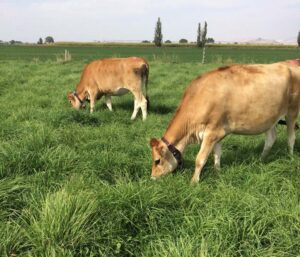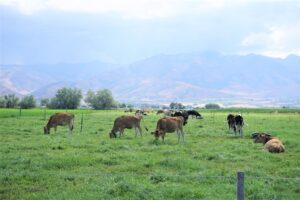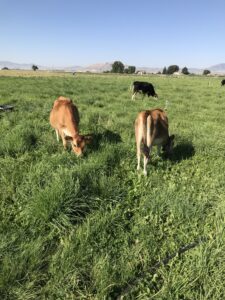Final report for SW21-927
Project Information
In 2019, there were over 3.6 million dairy cows in the western U.S. [1], making dairy a dominant sector of the region’s agriculture. Organic milk production is becoming more prevalent, with organic products increasing from 1.92% to 4.38%, of all milk products sold, between 2006 and 2013 [2]. Organic milk companies promote their product based upon the health and environmental benefits of pasture-raised milk [3], and require at least 120 grazing days per year for both lactating cows and replacement heifers [4]. However, milk production is 32% lower in dairies using 75-100% of pasture-based forage compared to those using 25% or less pasture forage [5]. Insufficient dry matter intake (DMI) of pasture by dairy cows is a major factor limiting milk production [6], and it has been observed that some dairy breeds are more efficient grazers than others [7-9]. Therefore, improved feed efficiency - the relative ability of a cow to convert feed into growth or milk, is increasingly important in pasture-based dairy systems [10, 11].
This proposal expands our previous Western SARE projects that evaluated how grass-legume pastures with different energy, protein, and condensed tannin (CT) levels affected beef steer and Jersey heifer growth performance (SW10-088 and SW17-046). Those studies found that forage characteristics only explained 50% of the variation in DMI and average daily gain (ADG) [12, 13]. Furthermore, producers on our research team asked about the influence of dairy breed on performance within their pasture-based systems. Thus, we propose to investigate the effects of dairy breed, pasture type, and breed-by-pasture type interactions on DMI, feed efficiency, and environmental and economic sustainability of heifers raised in pasture-based systems. A multi-disciplinary team will conduct this research at the Utah State University Lewiston Pasture Research Facility where replicated pastures of grass monoculture (MONO) or grass-birdsfoot trefoil (MIXED) are established. Four breeds of dairy heifers (Holstein, Jersey, Holstein/Jersey crossbreds, and 3-way Holstein/Montbeliarde/Viking Red crossbreds [i.e., ProCROSS]) will be compared as they rotationally graze pasture treatments (MONO vs MIXED) throughout the summer. Producer cooperators will provide dairy heifers and participate in DMI and forage evaluation of pastures on their dairies.
Outreach is a major component of the proposal with contributions from university extension and eOrganic. This program will integrate traditional outreach with electronic media and be guided by input from producer cooperators and similar stakeholders. The primary targeted audiences will be dairy producers, Extension educators, NRCS personnel, and other professionals who advise farmers/ranchers. Emphasis will be on providing opportunities to train these individuals in the local area, statewide, and across the western region.
These objectives are in direct response to stakeholder feedback and are expected to identify differences in feed efficiency. It is anticipated that some breeds will respond to both high quality (MIXED) and lesser quality (MONO) pastures, whereas, some breeds will respond only to high-quality pastures. At the end of the research, we expect to provide producers with solid scientific AND economic data on pasture-based dairy heifer development for a variety of pasture-types and dairy breeds.
RESEARCH OBJECTIVES
Our long-term goal is to enhance the sustainability of pasture-based dairy. The central hypothesis of the current proposal is that genetic background (“breed”) will have a significant influence on the physiological responses of dairy heifers grazing grass/birdsfoot trefoil (MIXED) or grass-only (MONO) pastures, and these differences will be reflected in measures of environmental and economic sustainability. Specific research objectives are:
1: Determine the influence of dairy breed on DMI and feed efficiency in heifers grazing either grass-monoculture or grass/birdsfoot trefoil mixed pastures. We hypothesize that DMI and feed efficiency will differ across breeds but will be greater in MIXED pastures compared to MONO pastures for all breeds. We also anticipate that some breeds will have greater feed efficiency relative to other breeds on lesser quality pastures.
2: Evaluate the influence of dairy breed on nutrient leaching when grazing either grass-monoculture or grass/birdsfoot trefoil mixed pastures. We hypothesize that animals grazing the pastures with the CT-containing birdsfoot trefoil (MIXED) will have improved nitrogen (N) utilization as measured by reduced N in groundwater leachate compared to those grazing grass monocultures, and that greater feed efficiency will be associated with greater N-utilization efficiency.
3: Ascertain the influence of dairy breed on the economic sustainability of pasture-based heifer development. We hypothesize that heifer breed/pasture type combinations with relatively greater feed efficiency will have greater annual net financial impact and reduced payback period.
EDUCATION OBJECTIVES
As part of our long-term goal to enhance the sustainability of pasture-based dairy, we will implement an innovative and impactful multi-faceted extension/outreach program on the production and environmental benefits of pasture-based dairy heifer development. Pasture-based milk production is a fast-growing segment of agriculture in the Intermountain West and this project will bridge the gap in urgently needed information regarding breed and pasture-type differences. We have devised a solid research plan that will generate a wealth of highly novel data across a very broad and multidisciplinary research spectrum. The results from this study will be of value to the scientific and pasture-based dairy farming communities in general, but our research/outreach effort is designed to translate this information to make a real difference to individual dairy farmers and their families throughout the Intermountain West. Specific education objectives are:
1: Implement an innovative and impactful multi-faceted extension/outreach program for producers and professionals in the local area, statewide, and across the western region on the production, environmental, and economic benefits of grass/legume grazing for pasture-based dairy production systems.
2: Create and pilot the Intermountain Regional Dairy Grazing School.
3: Produce and publish scholarly and educational products.
See attached pdf for a picture of the Excel Gantt chart that will be used for this research project.
Cooperators
- - Producer
- - Producer
- (Researcher)
- (Educator)
- (Researcher)
- (Researcher)
- - Producer
Research
The central hypothesis of the current proposal is that genetic background (“breed”) will have a significant influence on the physiological responses of dairy heifers grazing grass/birdsfoot trefoil (MIXED) or grass-only (MONO) pastures, and these differences will be reflected in measures of environmental and economic sustainability.
OBJECTIVES
Our long-term goal is to enhance the sustainability of pasture-based dairy. The central hypothesis of the current proposal is that genetic background (“breed”) will have a significant influence on the physiological responses of dairy heifers grazing grass/birdsfoot trefoil (MIXED) or grass-only (MONO) pastures, and these differences will be reflected in measures of environmental and economic sustainability. Specific objectives are:
1: Determine the influence of dairy breed on DMI and feed efficiency in heifers grazing either grass-monoculture or grass/birdsfoot trefoil mixed pastures. We hypothesize that DMI and feed efficiency will differ across breeds but will be greater in MIXED pastures compared to MONO pastures for all breeds. We also anticipate that some breeds will have greater feed efficiency relative to other breeds on lesser quality pastures.
2: Evaluate the influence of dairy breed on nutrient leaching when grazing either grass-monoculture or grass/birdsfoot trefoil mixed pastures. We hypothesize that animals grazing the pastures with the CT-containing birdsfoot trefoil (MIXED) will have improved nitrogen (N) utilization as measured by reduced N in groundwater leachate compared to those grazing grass monocultures, and that greater feed efficiency will be associated with greater N-utilization efficiency.
3: Ascertain the influence of dairy breed on the economic sustainability of pasture-based heifer development. We hypothesize that heifer breed/pasture type combinations with relatively greater feed efficiency will have greater annual net financial impact and reduced payback period.
METHODS AND MATERIALS
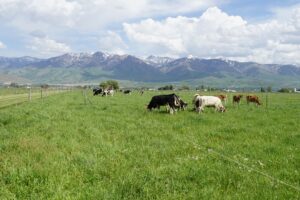
Objective 1. Determine the influence of dairy breed on DMI and feed efficiency:
Updated pasture treatments, grazing, and dry matter intake (DMI) and feed efficiency (FE) methods used are described below and in detail in Greenland, M.S.; Waldron, B.L.; Isom, S.C.; Fonnesbeck, S.D.; Peel, M.D.; Rood, K.A.; Thornton, K.J.; Miller, R.L.; Hadfield, J.A.; Henderson, B., et al. Dry matter intake and feed efficiency of heifers from 4 dairy breed types grazing organic grass and grass-birdsfoot trefoil mixed pastures. J Dairy Sci 2023, 106, 3918-3931, doi:10.3168/jds.2022-22858.
- (link to the paper here: Dry matter intake and feed efficiency of heifers from 4 dairy breed types grazing organic grass and grass-birdsfoot trefoil mixed pastures - ScienceDirect)
Pasture Treatments: This experiment was conducted at the Utah State University Intermountain Pasture Research Farm (41°57'01.85" N, 111°52'15.75" W, elev. 1,369 m, 46 cm annual precipitation and 56.1 precipitation d/year) located near Lewiston, Cache County, UT, USA. The soils at the site are a Kidman Fine Sandy Loam and Lewiston Fine Sandy Loam (both are Coarse-loamy, mixed, superactive, mesic Calcic Haploxerolls). This semiarid Central Great Basin region of the western USA is characterized by hot, dry summers with most of the annual precipitation as snowfall. The precipitation from winter-time snowfall is stored in reservoirs and used for irrigated crop production (Utah Climate Center, 2018).
The study utilized previously established pastureland described by Rose et al. (2021; SW17-046). For this study, fencing was arranged on this established pastureland to accommodate three randomized complete blocks of a 4 × 2 factorial design with 4 levels of dairy breed-type and 2 levels of pasture-type [i.e., grass monoculture (MONO) and grass-BFT mixture (MIXED)]. This pastureland had been established with endophyte-free tall fescue (‘Fawn’, TF), meadow bromegrass (‘Cache’, MB), high-sugar orchardgrass (‘Quickdraw’, OG), and high-sugar perennial ryegrass (‘Amazon’, PR) in grass monocultures or as binary mixtures with BFT (‘Pardee’). Within each of three blocks, our 8 (i.e., four MONO and four MIXED) pastures (on average 0.42 ha each) were established by fencing perpendicular across the existing grass monoculture and grass-BFT strips such that each MONO pasture included all grasses, and each MIXED pasture included all grass-BFT combinations. Each of the 8 pastures were further divided evenly into 10 paddocks with a single strand of charged poly-wire.
The pastures had been managed using organic dairy grazing protocols since 2015, so no treatments received commercial fertilizer or any pesticides. However, approved organic sources of nitrogen were applied. Prior to the current study in 2017 and 2018, Chilean nitrate (sodium nitrate, 15-0-2, N-P-K; SQM) was applied at 91 and 28 kg N/ha for monocultures and mixtures respectively. In 2019, Chilean nitrate was applied at 28 kg N/ha in April to all treatments (both MONO and MIXED). In 2020 and 2021, Chilean nitrate was not available, so Nature Safe (feather, meat, and blood meal, 13-0-0 N-P-K; Darling Ingredients Inc. Irving, TX) was applied at 33 kg N/ha in April to all treatments. Pastures were sprinkler irrigated every 14 d from mid-May to September such that they received 7.6 cm of total water/irrigation period (i.e., precipitation + irrigation; ~100% grass evapotranspiration replacement).
Heifer Grazing: For each of 3 grazing seasons (2019, 2020, and 2021), groups of 4 pre-pubertal dairy heifers (e.g., testers) from each of 4 dairy breed-types were considered an experimental unit and were randomly allocated to each pasture (Total testers = 288 heifers = 24 experimental units/year [i.e., 3 blocks × 4 breed-types × 2 pasture-types] × 4 heifers × 3 years). The 4 breed-types of dairy heifers used in this experiment were Jersey, Holstein, Holstein-Jersey crossbreds, and three-breed rotational crossbreds of Montbéliarde-Swedish Red-Holstein (in the 2019 and 2021 season) or of Montbéliarde-Viking Red-Holstein (in 2020, this crossbred with Viking Red is also marketed as ProCross© by Coopex Montbeliarde, Roulans, France and Viking Genetics, Randers, Denmark). The heifers were leased from various commercial dairies in Utah and Southern Idaho and returned to their owners at the end of the summer grazing. Heifers were on average 7.4 ± 0.8 months old and 32% mature body weight (BW) at the beginning of the trial. Animals were cared for in accordance with the guidelines of the Institutional Animal Care and Use Committee at Utah State University (IACUC protocol #10063).
Grazing was initiated on the same calendar date for all treatments, when most grasses had reached the E0 stem elongation stage (Moore et al., 1991) and were approximately 25 cm in height (e.g., mid-May). A fixed stocking rate of 4 heifers/pasture was used throughout the study; however, the 3 blocks had slight differences in size (0.47, 0.44, and 0.35 ha for block 1, 2, and 3 respectively) resulting in stocking rates of 8.5, 9.1, and 11.4 heifers/ha for blocks 1, 2, and 3, respectively. This stocking rate was predetermined based upon heifer utilization previously reported for this pastureland (Rose et al., 2021), and with the objective to ensure excess herbage (e.g., high herbage allowance) in order to emphasize the nutritive value effects on DMI and heifer performance (Baudracco et al., 2010, Sollenberger and Vanzant, 2011). There was no herbage target end-points for grazing a particular paddock. Rotational stocking was used with a set stocking period of 3.5 d, followed by a rest period of 31.5 d for each of the 10 paddocks, such that the entire rotation cycle was 35 d. There were 3 rotation cycles each year, thus, heifers were on pasture for a total of 105 d (11 May to 24 August 2020; 17 May to 30 August 2021). However, in 2019, heifers were on pasture for a total of 118 d (29 May to 24 September 2019), when due to excessive herbage growth all heifers in all treatments were moved to overflow pastures of the appropriate type (i.e. MONO or MIXED) towards the end of rotation 1 to allow the pastures to be mechanically harvested and allowed to regrow prior to beginning the regular second rotation.
Herbage Evaluation: Pre-grazing and post-grazing herbage samples were collected just prior to (pre-) and after (post-) heifer relocation to the next paddock, by hand-clipping two random quadrats (0.25 m2)/paddock to a stubble height of 3.8 cm. Post-grazing samples were taken adjacent to the pre-grazing samples unless the heifers defecated or laid on the area. Samples were put in separate paper bags and dried at 60°C for at least three d before being weighed to determine quadrat herbage mass. Pre- and post-grazing standing sward heights (cm) measured with a meter stick and compressed sward heights (cm) measured with a rising plate meter (RPM) were taken directly on each unclipped quadrat. At the same time, we found the mean of 30 RPM measurements taken in a ‘w’ pattern throughout each paddock (two 30-RPM-measurement means were taken in 2020 and 2021). Individual quadrat herbage mass measurements were regressed against respective RPM measurements, forcing a zero intercept as described by Dillard et al. (2016), to develop herbage mass prediction equations within each grass species and pasture-type (R2 for these regressions ranged from 0.80 to 0.89). Paddock-based pre- and post-grazing herbage mass were then predicted using these equations and the 30-RPM-measurement mean herbage height. In addition to pre- and post-grazing RPM measurements, one (2019) or two (2020 and 2021) 30-RPM measurement means (in the ‘w’ pattern) were taken at 24 and 48 h after grazing initiation in each paddock and fitted to their respective regression equations to determine herbage mass at these time points. After heifers finished grazing a paddock, excess herbage was mowed to a stubble height of 12 cm and clippings removed. In 2020, paddocks were mowed after all rotations, and in 2021, paddocks were mowed after rotations 1 and 2 (stubble height after rotation 3 was equal to or less than 12 cm). Immediately after mowing, a 30-RPM-measurement mean was taken in each paddock, followed by another at 24 h and 48 h after mowing. Herbage mass (HM) was estimated using these RPM measurements and the appropriate regression equation. Daily herbage accumulation (kg/ha per day) (e.g., regrowth) was then estimated as the increase in HM between these timepoints. In 2019, no regrowth RPM measurements were taken, so daily herbage accumulation was estimated as the mean of the 2020 and 2021 regrowth values on a pasture-type × rotation basis. Herbage allowance (HA) (kg of herbage/kg of BW) was calculated at the beginning of each rotation cycle. Estimates of potential grazing efficiency (i.e., the proportion of herbage assumed consumed by livestock compared with herbage that disappears due to other activities) as effected by herbage mass were calculated as in Rose et al. (2021) by inputting modified HA (on a per d basis) in a regression equation developed from the Allison et al. (1982) comparisons of herbage allowances and grazing efficiencies (i.e., grazing efficiency, % = 105.11 – 463.30 × modified HA; R2 = 0.93; Mean 92, StdDev 6.5, range 100 to 64).
Dried herbage samples were be ground to pass through a 1-mm screen using a Thomas Wiley Laboratory Model 4 mill (Arthur H Thomas Co, Swedesboro, NJ, USA), and scanned with a Foss XDS near-infrared reflectance spectroscopy (NIRS) instrument (Foss, Eden Prairie, MN, USA) to determine nutritive value of the feed on offer. The 2018 NIRS Forage and Feed Testing Consortium (Hillsboro WI, USA) equations were used to predict nutritive value, resulting in estimates of crude protein (CP), neutral detergent fiber (NDF), acid detergent fiber (ADF), acid detergent lignin (ADL), in vitro true digestibility (IVTD), NDF digestibility (NDFD), fatty acids (FA), water soluble carbohydrates (WSC), and ash. Net energy for maintenance (NEm) and net energy for gain (NEg) were calculated as as per Saha, et al. (2010) (e.g., using TDN; not ADF-based). In addition, the proportion of BFT and condensed tannin concentrations in each clipped sample was determined with NIRS using the methodology described by Rose et al. (2021).
Heifer performance and Dry-Matter Intake: All heifers were individually weighed at the beginning of the study, and after each 35-d rotation cycle to determine BW and ADG. The total BW of heifers in each experimental unit were recorded and converted to standard animal units (AU) to equalize all breed-type treatments over the grazing season and years. Standard AUs are defined as a heifer at 40% of mature BW for each breed-type, as determined by published growth charts and calculated on a metabolic weight basis (Allen et al., 2011). Apparent DMI was based upon herbage disappearance and estimated as the difference between pre-grazed and post-grazed HM (kg/ha) with adjustments made for both daily herbage accumulation and grazing efficiency as: DMI per grazing period = {[pregrazing HM = (daily herbage accumulation x 3.5 d of grazing)] - postgrazing HM} x grazing efficiency x paddock size. DMI was reported as daily DMI (i.e., divided by 3.5 days) per 100 kg of heifer BW and per AU. Daily NDF, net energy for maintenance (NEm), and net energy for gain (NEg) intake were estimated by multiplying DMI by the proportion of these nutritive components in the herbage. Lastly, grazing adaptation, or how quickly heifers responded to a new paddock and what happened as they stayed on that paddock, was estimated by calculating a grazing rate. Grazing rate (kg DMI/h) was calculated using the above DMI equation, except herbage disappearances were based on the intervals between 0, 24, 48, and 84 hours of grazing for each paddock (e.g., 0 to 24 h intake in kg DMI/h).
Feed Efficiency: Feed efficiency, the relative ability to convert nutrients into growth, was evaluated as FCE (ratio of weight gain to DMI), energy conversion (ratio of weight gain to NEm and NEg intake), and residual feed intake (RFI; the difference between actual intake and intake predicted from growth performance). Because DMI was not estimated for each individual heifer and heifer BW was only measured every 35 d, all feed efficiency estimates were based upon average performance of the four tester heifers in an experimental unit for each rotation of grazing. Feed conversion efficiency was estimated as BW change per rotation divided by the sum of daily DMI for that entire 35 d rotation. Higher numbers indicated better efficiency (Sainz and Paulino, 2004, Smith et al., 2010). Similarly, energy conversion was estimated by substituting NEm and NEg intake for DMI as the divisor. It is noted that FCE and energy conversion ratios cannot be corrected on an AU basis (e.g., because AU units cancel out when dividing) so are only reported on a per 100 kg BW basis.
Residual feed intake was estimated as the difference between actual intake and intake predicted based upon growth performance, with lower RFI values indicative of higher efficiency since the expected weight gain is obtained with less intake (Sainz and Paulino, 2004). Predicted DMI was determined by first creating separate multiple regression models for each year by regressing each experimental unit grazing rotation average DMI on corresponding ADG and mid-rotation BW0.75 (Williams et al., 2011, Waghorn et al., 2012). The models were then fit to each experimental unit × rotation × year data point as: Y = β0 + β1X1 + β2X2 + ε, where Y is expected DMI, β0 is the intercept and β1 and β2 are the partial regression coefficients from the regression models, X1 is observed mid-rotation metabolic BW (i.e., BW0.75), X2 is observed ADG, and ε is the residual error. Inasmuch as the beginning % mature BW (%MBW) for Holsteins were lower compared to the other three breed-types, this procedure (on an AU basis) was repeated using beginning %MBW and beginning %MBW2 as covariates in the regression equation similar to the use of heifer age by Williams et al. (2011). However, since AU already attempts to standardize differences among years and breed-types, the REG procedure of SAS (SAS Institute Inc., Cary, NC, USA) with the ‘BACKWARD’ selection option was used (i.e., fits the full model and then eliminates regression variables that do not contribute to the model, we used a conservative criterion of P=0.20) to reduce likelihood of over-fitting expected DMI models. Because RFI results varied depending upon whether on a 100 kg BW, AU, or AU with beginning %MBW covariate basis, all three estimates were reported.
Other Heifer Data: All heifers were weighed, body condition scored, and had blood, fecal, and rumen samples drawn at the initiation of grazing, and at the end of every 35 day grazing cycle thereafter. Blood samples were taken from the jugular vein into red-top vacutainer tubes and then stored on ice before being divided into two subsamples with one subsample centrifuged to remove the serum. Serum was then stored in a -20°C freezer until assayed. The whole blood subsample was stored at 4°C until used for DNA extraction. In 2021, ear notches were used for DNA analysis Ear notches were taken from the heifers at the beginning of study. One ear from each heifer's ear was clipped resulting in an approximately 0.5 cm diameter circle of each ear tissue. Each ear notch was placed in a labeled tube and was stored at -20 until DNA extraction was performed.
Rumen fluid was collected seven days after weight collection days (i.e. on days 7, 42, 77, and 112) to avoid complications associated with animal fasting on the regular weighing and sample collection days. Rumen fluid samples were collected using an esophageal tub, with approximately 100 mL of fluid collected from each animal. Of this sample, 50 mL was placed directly (fluid and associated ingesta/particulate matter) into a 50 mL conical tube for microbiome analysis, while the rest was filtered to remove particulates and placed in another 50 ml conical tube. Both tubes were stored in -80°C freezer until needed. Excess rumen fluid was discarded, and instruments rinsed with clean water between each animal. Rumen ammonia and volatile fatty acids concentrations were determined. Rumen microbial DNA was isolated and sequenced.
Blood urea nitrogen was analyzed in triplicate for each animal using a commercially available kit that provided compatibility with bovine serum (Urea Nitrogen (BUN) Colorimetric Detection Kit; Thermo Fisher Scientific; Waltham, MA, USA). The included kit protocol was strictly followed. Briefly, 40 µL of serum was added to deionized water to create a 1:10 dilution. Using a provided Urea Nitrogen Standard, standard solutions were created according to the kit protocol with concentrations ranging from ten to zero mg/dL. Using the provided 96 well plate, 50 microliters of standards (in duplicate) and diluted serum samples (in triplicate) were placed into appropriate wells. Seventy-five microliters each of two color reagents (Reagent A and then Reagent B) were placed into all wells. Plates were then covered to protect from light and allowed to incubate at room temperature for 30 minutes. Plates were read using a SYNERGY H1 microplate reader (BIOTEK; Winooski, VT) and GEN 5 2.9 absorbance reading software at a wavelength of 450 nm. All three sample values for each animal were then averaged and that outcome became the heifer’s serum BUN value for that timepoint.
Fecal samples were refrigerated at 4° C after collection. All fecal floats were analyzed in our laboratory via the Wisconsin Sugar Flotation Method (University of Pennsylvania School of Veterinary Medicine, Dr. Thomas Nolan. Copyright 2006) within 48 hours of collection. Briefly, 10 ml of Sheather’s solution (3.72 M sucrose in water) was added to three grams of feces and mixed thoroughly. This mixture was then put through a strainer and the fluid portion was placed in a 15 ml tube and centrifuged for four minutes at 2008 x g. The test tube was then filled completely with Sheather’s solution and a cover slip was placed on the meniscus and left for five minutes. The cover slip was then removed and placed on a glass slide. Parasitic eggs were then counted as the slide was viewed under a microscope with a magnification of 100x.
In addition to the pasture grazing, three feedlot replicates of three heifers per breed were fed a TMR formulated for an ADG target of 0.8 kg/day, and feed offered and refused each day weighed to calculate TMR DMI (only in 2019 and 2020). Heifer growth, herbage physical and chemical characteristics, DMI, and feed efficiency data was analyzed using the Proc Mixed procedure of SAS, and the effects of dairy breed and pasture-type treatments and their interactions reported. Heifer growth and DMI comparisons will be made between pasture versus TMR treatments.
Objective 2. Evaluate the influence of dairy breed on nutrient leaching: Soil water (leachate) nitrogen will be monitored by means of 90-cm suction-cup lysimeters (below the root zone). Leachate will be collected every week during the growing season, and as much as possible throughout the early spring and late fall. The leachate will be analyzed for nitrate-nitrite concentration using QuickChem Method 10-107-04-1-C on the Lachat Auto-analyzer. Leachate concentration and volume will be used to determine total leachate N.
To monitor any potential buildup of soil nitrogen, soil samples to a depth of 30 cm will be collected prior to grazing, and in the fall after the growing season each year. To account for the variability that may result from grazing, ten soil cores will be taken in each plot and combined to make a composite soil sample. Composite soil samples will be analyzed for available nitrogen (NO3-N) using potassium chloride on the Lachat Auto-analyzer, QuickChem Method 10-107-04-1-C.
Nutrient cycling and N-use efficiency will be evaluated by studying the relationships between herbage N intake (Object. 1) with N loss in leachate and the soil (Object. 2) and fecal, urine urea, and blood urea N (data obtained separate from this proposal). Breed effect on N leaching and N-utilization efficiency when grazing grass monocultures vs grass-BFT mixtures will be determined and differences reported. Data will be analyzed using SAS PROC Mixed with Repeated Measures.
Objective 3. Ascertain the influence of dairy breed on the economic sustainability of pasture-based heifer development: Partial budgeting techniques were used to determine the cost differences from each heifer development program. Costs associated with feeding the different breeds of heifers in order to reach breeding weight (55% mature body weight) were determined.
The partial budgets will be used to quantify the impact of heifer performance, under each pasture-type and TMR, on the economic value of the four breeds in part following the methodology described by Feuz, et al. [29]. This analysis evaluates the total feed costs (TFC) associated with raising dairy heifers across different breed types and pasture treatments. The study considered three feeding systems: two pasture-based systems—grass monoculture (Mono) and grass-birdsfoot trefoil mixture (Mix)—and a total mixed ration (TMR) control. The economic comparison accounts for differences in feed costs due to variations in daily dry matter intake (DMI), pasture rental rates (i.e., opportunity cost of grazing), and the cost of TMR.
Grazing and TMR Cost Assumptions were:
-
- Days on Feed (DOF): The grazing treatments assumed a fixed 120-day grazing period, after which heifers were transitioned to a TMR diet until they reached the 55% mature body weight (MBW) breeding threshold.
- Feed Intake: Predicted DMI values for each breed and pasture type were used to calculate total feed consumption.
- Grazing Cost Calculation: Grazing feed costs ($/kg DM) were derived from an assumed pasture rental rate of $50/hectare, adjusted assuming 70% utilization of the available forage and observed dry matter yields (kg/ha).
- TMR Cost Calculation: Five-year U.S. average prices of TMR components (from USDA, NASS Quick Stats, 2025) were used to estimate the $/kg as fed cost of the TMR. This as fed cost was then adjusted to a DM cost ($/kg.) based on the estimated DM percentage of the TMR.
- Total Feed Costs (TFC): The sum of total grazing feed costs and total TMR feed costs were calculated for each breed-treatment combination. The difference in TFC between the grazing treatments and the control TMR was also calculated to assess potential cost savings from implementing a grazing period on Mono or Mixed pastures.
PROGRESS REPORT
Progress and to-date results are reported by Objective. The most recent progress report appears first under each objective, with previous reports still included and designated by date. The latest tables and graphs are numbered consecutively beginning from the previous report. However, outdated tables and graphs may be replaced when noted with the published version once the research has been published.
Notable revisions/additions in the report:
- A new 'Milestone Table' was added that gives completed or anticipated completion dates for each component within each objective.
-
When any Objective was completed, the Methods and Materials for that objective were updated to reflect what happened.
-
A 'Lessons Learned' section was added for each sub-component that was completed.
- Shortly after the initiation of this research, results from our previous Western SARE project (SW17-046) indicated that insulin-like growth factor 1 (IGF1) was primarily affected by differences in the amount of time each heifer was fasted prior to weighing and blood collection (12 to 18 hours depending upon when they crossed the squeeze chute). Therefore, we replaced this assay with an ammonia concentration in the rumen fluid assay that had been shown to be related to diet. The Materials and Methods were updated to reflect this change.
- Though the primary aim proposed in objective 1 was to investigate DMI and feed efficiency, the complexity and labor involved in a grazing study necessitates getting all the information possible from the livestock samples we were collecting. Thus, though blood urea nitrogen (BUN), fecal egg count (FEC), rumen microbiome analysis, and heifer genome analysis were not part of the original proposal for SW21-97, we were able to leverage the blood, rumen, and fecal samples from SW21-927 to get these extra data sets. These additional investigations are now in our Objective 1 progress report and used to help complete two additional M.S. theses in the USU Animal, Dairy and Veterinary Sciences Dept (for a total of four M.S. theses from this research project). These expanded datasets and research goals will give us a better overall picture of the effects of breed and pasture-type on growth performance. It should be noted that the rumen ammonia and VFA concentration results (which replaced the IGF1 assay) have been combined with the microbiome data and comprise one M.S. thesis. This combined and expanded data set will help us have a better understanding of livestock performance variation when grazing different pastures. The heifer genome analysis which comprises the other additional M.S. thesis, will provide preliminary data on how genetic variation within and among breeds affects dairy heifer growth performance when grazing different types of pastures.
Milestone Table for SW21-927: Dry Matter Intake and Feed Efficiency of Four Dairy Breeds in a Pasture-Based Heifer Development Program.
|
Objective/sub-objective |
Milestone |
Status |
Anticipated Completed Date |
Team Lead |
|
1. Determine the influence of dairy breed on DMI and feed efficiency |
|
|
|
|
|
a. Heifer growth performance |
Field data collected for 3 yrs (e.g., body wt, body condition score, rumen samples) |
Completed |
September 2021 |
Isom |
|
|
Ammonia and VFA in rumen fluid assay |
Completed |
December 2021 |
|
|
|
Growth and rumen fluid statistical analyses |
Completed |
October 2023 |
|
|
|
Manuscript |
Completed |
December 2024 |
|
|
|
eOrganic webinar |
|
2025 |
|
|
|
Fact sheet |
|
2025 |
|
|
|
|
|
|
|
|
b. DMI and feed efficiency (FE) |
Field data collected for 3 yrs (e.g., herbage samples collected) |
Completed |
September 2021 |
Waldron |
|
|
Forage quality analysis |
Completed |
January 2022 |
|
|
|
DMI and FE calculations |
Completed |
January 2022 |
|
|
|
DMI and FE statistical analyses |
Completed |
February 2022 |
|
|
|
DMI and FE Manuscript |
Published |
January 2023 |
|
|
|
eOrganic webinar |
Completed |
May 2022 |
|
|
|
|
|
|
|
|
c. Rumen microbiome DNA analysis1 |
Rumen microbial DNA isolation and sequencing |
Completed |
September 2021 |
Isom |
|
|
Microbiome population/DNA analysis |
Completed |
June 2023 |
|
|
|
Statistical analyses |
Completed |
February 2024 |
|
|
|
Manuscript (M.S. thesis) |
Completed |
December 2024 |
|
|
|
|
|
|
|
|
d. Heifer DNA analysis1 |
Blood and/or ear notch samples collected for 2 years |
Completed |
September 2021 |
Isom |
|
|
DNA extractions |
Completed |
December 2023 |
|
|
|
DNA commercial lab analysis/Index scores |
Completed |
February 2025 |
|
|
|
Statistical analyses |
|
2025 |
|
|
|
Manuscript |
|
2025 |
|
|
|
|
|
|
|
|
2. Evaluate the influence of dairy breed on nutrient leaching |
|
|
|
Miller |
|
|
Leachate and soil samples of 4 breeds collected for 3 yrs |
Completed |
May 2022 |
|
|
|
Fecal and Urine samples of 4 breeds collected for 3 years |
Completed |
September 2021 |
|
|
|
Urine, fecal, and leachate samples analyzed for available N and nutrient cycling for Jersey heifers – Reference point for 4-breed study |
Completed |
September 2024 |
|
|
|
Jersey heifer nutrient cycling reference point published in peer-reviewed journal |
|
2025 |
|
|
|
Leachate from 4 breeds analyzed for nitrate-nitrite |
|
2025 |
|
|
|
Soil samples from 4 breeds analyzed for available N |
|
2025 |
|
|
|
Nutrient cycling and statistical analyses of 4 breeds |
|
2025 |
|
|
|
Manuscript |
|
2026 |
|
|
|
Webinar |
|
January 2026 |
|
|
|
Fact sheet |
|
February 2026 |
|
|
|
|
|
|
|
|
3. Ascertain the influence of dairy breed on the economic sustainability of pasture-based heifer development |
|
|
|
Larsen |
|
|
Partial budgets |
Completed |
December 2024 |
|
|
|
Calculate economic values: impact of performance and pasture type |
Completed |
December 2024 |
|
|
|
Statistical analyses of net annual financial impact |
Completed |
December 2024 |
|
|
|
Prepare Tables, etc for inclusion in heifer growth manuscript |
Completed |
February 2025 |
|
|
|
Fact sheet |
|
2025 |
|
1Not part of the proposal for SW21-97. However, the data and samples from SW21-97 are being leveraged to help complete these two sub-objectives as part of two M.S. theses in the USU Animal, Dairy and Veterinary Sciences Dept.
Objective 1: Determine the influence of dairy breed on DMI and feed efficiency
1b. Grazing dry matter intake and feed efficiency
January 2025
- This component of the study was previously completed. No additional report.
January 2024
- This component of the study was previously completed. The published interpretative summary and abstract, which summarize the results from this study, as well as 'lessons learned' have been added to this report.
-
Interpretative Summary: Decreased dry-matter intake (DMI) of pasture by dairy cattle limits growth and milk production, however, pasture type and dairy breed may alter DMI. In a comparison of four dairy breed-types grazing grass or grass-legume mixtures, heifers grazing grass-legume mixtures had greater estimated DMI than those grazing grass-only pastures, but heifers on grass-only pastures were twice as efficient at converting the feed to growth. Holsteins had the greatest overall estimated DMI, but Jerseys had the most favorable feed efficiency. However, the lack of interactions between breed-type and pasture-type indicated that no breed-type was better adapted to pastures with contrasting levels of nutritive value.
- Abstract: Insufficient dry matter intake (DMI) of pasture by dairy cattle is a major factor limiting growth and milk production; however, it has been hypothesized that some dairy breeds may be more efficient grazers than others. This study was conducted to determine whether dairy breed types differ in DMI and feed efficiency when grazing either grass monoculture or grass-legume mixed pastures. The experiment compared 4 different dairy breed types (Jersey, Holstein, Holstein-Jersey crossbreds, and Montbéliarde-Swedish Red-Holstein 3-breed crossbreds) and 2 levels of pasture type [grass monoculture (MONO) and grass-birdsfoot trefoil (BFT) mixture (MX)] for a total of 8 treatments. Pastures were rotationally stocked with groups of 4 prepubertal heifers for 105 d for 3 yr, and estimated DMI (EDMI) was determined from herbage disappearance with adjustments made for daily herbage accumulation and grazing efficiency. Potential grazing efficiency (i.e., the proportion of herbage consumed compared to herbage that disappears due to other activities like trampling) was based upon herbage allowance using previously published regression equations. Feed conversion efficiency (FCE) and residual feed intake (RFI) were then derived from EDMI, and heifer body weights (BW) and normalized to animal units (AU) as 40% metabolic mature BW of the corresponding dairy breed type to account for inherent differences in size and growth rates. We observed differences in EDMI and feed efficiency among breed types and between pasture types. On average, Holsteins had the greatest overall EDMI (4.4 kg/AU), followed by intermediate EDMI by the crossbreds (4.0 kg/AU), and Jerseys had the least EDMI (3.6 kg/AU). Heifers grazing MX pastures had on average 22% greater EDMI than those grazing MONO, but heifers on grass monocultures were more efficient in converting DMI to BW gain (i.e., RFI/AU of 0.27 and−0.27, respectively; more negative RFI numbers indicate less DMI to achieve the expected gains). Overall, Jerseys had the most favorable feed efficiency; however, ranking of Holsteins and crossbreds depended upon the feed efficiency metric. This study is one of the first to compare the interaction of dairy breed and pasture quality on grazing efficiency. However, the lack of a breed type × pasture type interaction for DMI, FCE, or RFI indicated that none of these dairy breed types were better adapted than another breed type to pastures with contrasting levels of nutritive value.
- Lessons learned: The use of the rising plate meter (RPM) allows for more thorough sampling of paddocks than grab samples alone resulting in greater accuracy of herbage disappearance. In order to get meaningful DMI values, forage disappearance needs to be adjusted for daily herbage growth and a measure of grazing efficiency, which require prior planning. Therefore, in this study, we measured herbage regrowth and used published data to estimate grazing efficiency. Season-long grazing studies can be problematic due to bimodal herbage production (e.g., lots of growth in the spring, summer slump, and slight recovery in the fall). Our study used season-long set stocking rates, so we had to adjust for varying herbage by using low stocking rates (e.g. plenty of herbage throughout) but this requires some way to remove excess forage in the first grazing rotation. We used commercial mowers with either sweepers or blower/bag systems. In the future, estimating DMI per heifer, as opposed to groups of 4 heifers would be beneficial ... if possible. Different feed efficiency metrics result in different results, which requires thought on how to interpret.
April 2023
- In this reporting period, the thesis data were prepared and published in the Journal of Dairy Science (link to the paper here: Dry matter intake and feed efficiency of heifers from 4 dairy breed types grazing organic grass and grass-birdsfoot trefoil mixed pastures - ScienceDirect)
- Tables and figures for the bullet points of April 2022 report were updated to reflect the published version. The results were presented in an eOrganic webinar. This completes the DMI and feed efficiency component of Objective 1 (see milestone table).
April 2022
- Grazing intake and herbage measurements were collected during the 2019, 2020, and 2021 grazing seasons and used to determine estimated dry matter intake (EDMI) and feed efficiency. These data were analyzed and reported as part of the requirements for a Utah State University M.S. thesis (Michael Greenland). The main results of the thesis/publication were as follows:
- We used herbage disappearance to determine EDMI. Both feed conversion efficiency (FCE) and residual feed intake (RFI) were derived using heifer weight and EDMI. All measures were normalized to 40% metabolic mature body weight of the corresponding dairy breed to account for difference in size and growth of the heifers.
- We observed greater EDMI on grass-BFT mixtures. Among breeds, Holstein had the greatest EDMI, then the two crossbreds, and Jersey had the least (Figure 3).
- Feed efficiency was most favorable for Jersey, less efficient for both crossbreds, and Holsteins showed variable results depending upon efficiency measure (Figure 4 and 5).
- Grazing adaptation defined as change in EDMI during successive 24+ h increments over the 3.5 d grazing period was also considered, and EDMI declined throughout the grazing period for all breeds similarly on both pasture-types. In addition, no breed × pasture-type interactions were found for DMI, FCE, or RFI suggesting that no breed had an advantage on higher quality (grass-BFT mixture or early grazing period) or lower quality (grass monoculture or late grazing period) forage (Figure 6).
- Multivariate analyses will be conducted to identify forage quality parameters associated with growth performance, DMI, and feed efficiency.
1a. Heifer growth performance
January 2025
- This component of the study was completed during 2024. A manuscript was prepared and submitted for peer-review publication. It is currently under review. The interpretative summary, abstract, main table of heifer performance, as well as 'lessons learned' have been added to this report. Figures 1-9 were included in January 2024 and are at the end of the report.
-
Interpretative Summary: The largest expenses on most US dairy farms are nutrition and replacement heifer development. Producers are interested in using rotational grazing to reduce costs in both areas. Grazing animal performance has been well studied in lactating cows, but not in developing heifers in the US. In this study, we compared the growth of pre-pubertal heifers from four different breeds across three development strategies (two grazing; one mixed ration) in the US Intermountain West. The main and interactive effects of nutrient input and breed on growth parameters are described.
-
Abstract: Many different breeds of dairy cattle exist, but questions remain about their performance within exclusively forage-based systems in the United States. This paucity of data is especially apparent in relation to heifer development, which is the second largest expense on most dairy farms. We evaluated the performance of pre-pubertal heifers from four different breeds within a rotational-grazing system in the Intermountain West. For each of three 105-day grazing seasons, 24 dairy heifers from each of four different breeds [Holstein, Jersey, Holstein/Jersey crossbred, and Viking Red/Holstein/Montbeliarde crossbred] were randomly assigned to one of three treatments that consisted of either grazing grass only (MONO), grazing grass interseeded with the legume birdsfoot trefoil (BFT; MIX), or being fed a mixed ration in a feed bunk. Main effects of treatment and breed (and potential interactions) on heifer weight, average daily gain, hip height, body condition score, change in percent mature body weight, fecal egg count, and blood urea nitrogen levels were evaluated. There was a significant effect of pasture treatment on average daily gain, with heifers on MIX pastures having an average gain of 0.47 kg/day while those on MONO pastures gained 0.28 kg/day on average. Those on MIX pasture gained about half as much as the heifers on a TMR ration (0.92 kg/day). MIX had significant positive effects on daily gain, body condition score and change in percent mature body weight compared to MONO, regardless of genetic background. Overall, Jerseys gained a higher percentage of their mature body weight and lost less body condition while on pasture than heifers of other breeds. Neither hip height nor parasite load were impacted by breed or treatment. Both breed and treatment had significant effect on blood urea nitrogen levels. This research affirms and extends previous research suggesting that Jersey heifers may be suited particularly well to grow and mature sexually within forage-based systems – even with lower quality forages. The results of this study will be of value to dairy producers who might consider cutting costs by raising replacement heifers on pasture and those that otherwise provide pasture as a significant part of their animals’ diet. Specifically, these data confirm the value of interseeding legumes (BFT, e.g.) into pastures used for heifer development and they fill an important knowledge gap regarding how genetic background impacts metrics of growth under different development schemes.
|
Effect of Breed and Treatment on Weight, Percent weight gain of starting weight, Average Daily Gain, Increase in Percent Mature Body Weight, and Total Percent Hip Height Increase Over the 105-d Grazing Period1 |
||||||||||||
|
Animal Weight (kg) |
|
|||||||||||
|
Breed-Treatment |
Day0 |
Day35 |
Day70 |
Day105 |
Total Weight Gain (kg) |
Weight gain as a % of starting weight |
ADG (kg) |
Total increase %MBW2 |
Total %Hip Height increase |
|||
|
HO-MIX |
180 |
202 |
218 |
235 |
55c |
30bc |
0.50c |
8c |
7a |
|||
|
HO-MONO |
188 |
203 |
210 |
217 |
28d |
15e |
0.26d |
4d |
6ab |
|||
|
HO-TMR |
207 |
245 |
286 |
319 |
112a |
54a |
1.06a |
16a |
8a |
|||
|
JE-MIX |
148 |
167 |
181 |
197 |
49c |
33b |
0.44c |
11b |
7ab |
|||
|
JE-MONO |
149 |
162 |
170 |
184 |
35d |
24d |
0.32d |
8c |
7ab |
|||
|
JE-TMR |
158 |
186 |
206 |
235 |
77b |
49a |
0.73b |
17a |
5ab |
|||
|
HJ-MIX |
194 |
212 |
227 |
244 |
51c |
26cd |
0.46c |
9c |
6ab |
|||
|
HJ-MONO |
193 |
206 |
217 |
224 |
31d |
16e |
0.28d |
5d |
5b |
|||
|
HJ-TMR |
206 |
241 |
266 |
304 |
98a |
48a |
0.92a |
17a |
8a |
|||
|
PRO-MIX |
211 |
232 |
244 |
262 |
50c |
24d |
0.46c |
9c |
7ab |
|||
|
PRO-MONO |
212 |
227 |
231 |
240 |
28d |
13e |
0.25d |
5d |
6ab |
|||
|
PRO-TMR |
197 |
222 |
261 |
297 |
100a |
51a |
0.95a |
18a |
8a |
|||
|
MIX |
184 |
204 |
218 |
235 |
51b |
29b |
0.47b |
9b |
7ab |
|||
|
MONO |
186 |
200 |
207 |
217 |
31c |
18c |
0.28c |
5c |
6b |
|||
|
TMR |
192 |
225 |
255 |
289 |
97a |
51a |
0.92a |
17a |
8a |
|||
|
HO |
188 |
209 |
225 |
240 |
52a |
29a |
0.48a |
8bc |
7a |
|||
|
JE |
152 |
170 |
182 |
199 |
47b |
32a |
0.43b |
10a |
7a |
|||
|
HJ |
196 |
213 |
229 |
244 |
48ab |
25b |
0.45a |
9b |
6a |
|||
|
PRO |
208 |
227 |
239 |
256 |
48ab |
24b |
0.44ab |
7c |
7a |
|||
|
Treatment |
. |
. |
. |
. |
<0.01 |
<0.01 |
<0.01 |
<0.01 |
<0.01 |
|||
|
Breed |
. |
. |
. |
. |
<0.01 |
<0.01 |
<0.01 |
<0.01 |
0.22 |
|||
|
*Treatment |
. |
. |
. |
. |
<0.01 |
<0.01 |
<0.01 |
0.15 |
0.01 |
|||
|
1 Acronyms include HO: Holstein, JE: Jersey, HJ: Holstein x Jersey, PRO: ProCross, MIX: grass pastures with interseeded Birdsfoot Trefoil, MONO: grass pasture only, ADG: Average Daily Gain |
||||||||||||
|
2Mature weights used for each breed were: 682 kg for HO, 455 kg for JE, 568 kg for HJ, and 636 kg for PRO 3Means within each column that have a different superscript represent differences (P = 0.05) between treatments within each time point. |
||||||||||||
-
Lessons learned: Heifer to heifer differences in growth performance were the greatest source of variation, indicating the importance of sample size for testers. The average of groups of 4 testers allowed us to separate treatments. Outbreaks of pinkeye could have affected growth performance, and the organic-management nature of this project made it difficult to treat. How to quickly respond to these outbreaks needs to be planned for in future experiments. Year to year average season-long temperature differences may have affected performance. Inclusion of shade shelters should be considered in future experiments. The 3-breed crossbreds did not perform as expected by the cooperating producers. They usually came into the study with the highest BCS but in most cases gained a lower percentage of weight than the other breeds and often lost body condition. We thought that it might be the difference between those coming from feed-lot versus grass pasture backgrounds, but that did not prove to be the case. Because of the breed differences in size and growth rate among heifers of approximately the same age, a method of standardizing growth performance is critical for breed comparisons. Though we could not find it widely published, we still believe that using the percent of mature body weight was an appropriate and effective method.
January 2024
-
The following is an update on the Animal Health and Performance data for the Lewiston project. A thesis was defended in August of 2021 on project data from 2019 and 2020. Since that time data has been gathered from the 2021 year and has been organized in preparation for statistics. Those statistics have been completed on all but one of these data sets with the last set to be completed in the next month. With the data from all three years of the project, graphs have been created on the data with the Prisim graphing software. These graphs are attached with this report. Our entire project group will have a chance to view/critique the data/graphs/statistics within the next month. The revision of the manuscript to include the extra year (i.e., 2021) of data is ongoing with the anticipation that the manuscript will be completed and submitted to a scholarly journal for publication by March 2024.
- Preliminary results based upon the most recent graphs are as follows:
-
Figure 1 (updated): Measurement of Average Daily Gain over the course of a 105-d grazing period for each of four breeds (HO: Holstein, JE: Jersey, HJ: Holstein/Jersey crossbred, PRO: ProCross) with the three assigned treatments (MIX: grass + BFT, MONO: grass only, TMR: total mixed ration). Average daily gains within the TMR group were at or above 0.75 kg/day with the MIX group having average daily gains just short of the 0.5 kg/day mark. All treatment groups were significantly different from one another (significance at P<0.05).
-
Figure 2 (updated): Effect of breed (A) and treatment (B-E) on the cumulative change in percent Mature Body Weight (MBW) over the course of a 105-d grazing period for each of the four breeds (HO: Holstein, JE: Jersey, HJ: Holstein/Jersey crossbred, PRO: ProCross) with the three assigned treatments (MIX: grass + BFT, MONO: grass only, TMR: total mixed ration). All breeds had positive increases in percent MBW with JE having the greatest change. Across all breeds, heifers in the TMR treatment had the greatest overall positive increase in percent MBW with heifers in the MONO treatment having the least positive gain.
- Figure 7: Effect of breed and treatment on the Body Condition Score (BCS) over the course of a 105-d grazing period for each of the four breeds (HO: Holstein, JE: Jersey, HJ: Holstein/Jersey crossbred, PRO: ProCross) with the three assigned treatments (MIX: grass + BFT, MONO: grass only, TMR: total mixed ration). PRO started and ended with higher BCS than all other breeds. TMR groups within breeds overall gained BCS over the 105 day trial period while the pasture groups (MIX and MONO) overall lost BCS.
-
Figure 8: Effect of breed (A) and treatment (B) on the fecal egg count (FEC) over the course of a 105-d grazing period for each of the four breeds (HO: Holstein, JE: Jersey, HJ: Holstein/Jersey crossbred, PRO: ProCross) with the three assigned treatments (MIX: grass + BFT, MONO: grass only, TMR: total mixed ration). Regardless of breed, treatment or starting egg load, all animals ended the trial with a minimal number of fecal eggs.
-
Figure 9: Effect of breed (A) and treatment (B) on the Blood Urea Nitrogen (BUN) concentration over the course of a 105-d grazing period for each of the four breeds (HO: Holstein, JE: Jersey, HJ: Holstein/Jersey crossbred, PRO: ProCross) with the three assigned treatments (MIX: grass + BFT, MONO: grass only, TMR: total mixed ration). BUN saw a large increase for all breeds between day 70 and day 105. Heifers on MONO pastures had the greatest variability in BUN levels over the entire study period.
-
April 2023
- In this reporting period, the 2021 data were added to 2019 and 2020 data from Fonnesbeck's thesis, and the entire dataset underwent statistical analyses. Summary and manuscript preparation will begin in fall of 2023.
April 2022
- Heifers were weighed (BW), body condition scored (BCS), and blood and rumen fluid samples drawn at the initiation of grazing, and at the end of every 35 day grazing cycle during 2019, 2020, and 2021.
- The heifer growth performance data from 2019 and 2020 were analyzed and reported as part of the requirements for a Utah State University M.S. thesis (Sawyer Fonnesbeck). The main results of the thesis are summarized as follows:
- BFT significantly increased ADG for all breeds. Heifers which grazed the MIX treatments averaged 0.48 kg of gain/day, whereas heifers on MONO pastures averaged 0.28 kg/day. Overall changes in BCS were significantly affected by both the differences in pasture treatment and breed of the animals (Figure 1).
- The different treatments did not cause any significant differences in fecal egg count (FEC) or total rumen volatile fatty acids (VFA) concentrations.
- Overall, Jerseys were able to gain a higher percentage of their mature body weight and maintain their body condition better, while grazing, than heifers of other breeds (Figure 2).
- We determined that grazing BFT can have noticeable positive effects on ADG, BCS, and change in percent mature BW.
-
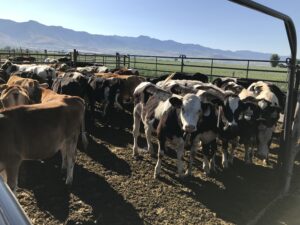
Sorting and weighing heifers on project SW21-927. 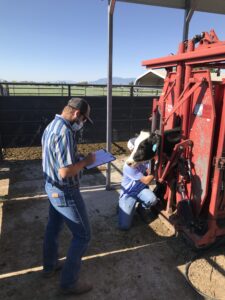
Weighing heifers on project SW21-927.
1c. Rumen fluid and rumen microbiome DNA analysis
- The rumen microbiome DNA analysis was not part of the original proposal for SW21-927. However, the data and samples from SW21-927 are being leveraged to help complete this sub-objective as part of a M.S. theses in the USU Animal, Dairy and Veterinary Sciences Dept. The rumen ammonia and VFA concentration results have been combined with this microbiome data for the thesis. This combined and expanded data will help us have a better understanding of varying livestock performance on different pastures.
January 2025
-
This component of the study was completed during 2024. A graduate student M.S. thesis was prepared and submitted to Digital Commons. It will be prepared for a future submission to a peer-reviewed journal. The abstract, which summarize the results from this study, has been added to this report. Figures 15 and 16 updated.
-
Abstract: There are variations in how well dairy heifers grow and develop while grazing pasture. The quality and amount of forage that they consume has been shown to account for approximately fifty percent of those variations. We hypothesized that the composition of the rumen microbiome would account for a significant portion of the remaining variation. To test this hypothesis, 288 dairy heifers from four different “breeds” were used. Holsteins, Jerseys, Holstein/Jersey crossbreds, and ProCROSS heifers were grazed on two different pasture types. Our two treatments were grass monoculture pastures and grass interseeded with birdsfoot trefoil. There were also 48 heifers as a control group that consumed a total mixed ration in a feedlot. Rumen fluid was collected at the start of the trial and then after each of three 35 d grazing rotations through the pastures. The rumen fluid was analyzed for ammonia and volatile fatty acid concentrations, and the rumen microbiome was characterized. Overall breed did not have an effect on ruminal ammonia (Figure 10), or any of the three primary VFA (acetate, propionate, or butyrate) (Figure 11-14). However, treatment did have an effect on ammonia, acetate, propionate, and butyrate concentrations in the rumen (Figure 10-14). There were differences in alpha diversity between some breeds with Holstein/Jersey cross and ProCross having greater alpha diversities than Holsteins and Jerseys (Figure 15). Breed did not have an effect on beta diversity (Figure 15). Both pasture treatments were different for alpha and beta diversities when compared to the TMR control group (Figure 16), but there were no differences between the two pasture types (Figure 16). Using growth data, heifers were ranked from worst to best. The microbiome profiles from the best 20% were compared to the worst 20%. Differences were found for both alpha and beta diversities between groups. There were also differences found for specific phylum, genus, and species between the top 20% and the bottom 20% of heifers, based on growth. It was therefore concluded that the rumen microbiome does have a significant effect on dairy heifer growth/performance and these findings provide an opportunity for dairies to increase the efficiency of raising dairy heifers through the rumen microbiome.
January 2024
-
See Milestone table. Rumen ammonia concentrations have been measured for all three years of data. Statistics have been run and a graph has been made. Rumen ammonia concentrations will be added to the other data sets in the manuscript submitted to a scholarly journal. Microbial DNA has been isolated from rumen fluid, from all three years, and the samples have been sequenced. Analysis of the sequencing data is underway. A master thesis on the microbiome data, rumen ammonia concentration data, and VFAs for all three years is underway, with a goal of completion by the end of April. Setbacks for this project have been many (mostly related to Covid 19). Needed lab supplies that were necessary for the isolation of the microbial DNA were set back by over 8 months. We do not have all of the equipment and expertise needed to sequence and analyze the sequenced data on our own, within our lab. We had arrangements to send samples outside our lab to be sequenced and the turnaround time was longer than anticipated.
- Preliminary rumen ammonia and VFA results based upon the most recent graphs are as follows:
-
Figure 10. Rumen Ammonia Concentrations: Effect of breed (A) and treatment (B) on the rumen ammonia concentration over the course of a 105-d grazing period for each of the four breeds (HO: Holstein, JE: Jersey, HJ: Holstein/Jersey crossbred, PRO: ProCross) with the three assigned treatments (MIX: grass + BFT, MONO: grass only, TMR: total mixed ration). There are no statistical differences between breeds. Significance set at P<0.05. There was more variation (by time) in the heifers that grazed pastures (MIX and MONO) as compared to the heifers consuming the TMR.
-
Figure 11. Acetate % of Total VFAs: Effect of breed (A) and treatment (B) on the percent acetate of the total VFAs over the course of a 105-d grazing period for each of the four breeds (HO: Holstein, JE: Jersey, HJ: Holstein/Jersey crossbred, PRO: ProCross) with the three assigned treatments (MIX: grass + BFT, MONO: grass only, TMR: total mixed ration). Acetate levels at day 0 varied among breed but eventually ended at similar points on day 105. Acetate was unchanged among treatment types except for the TMR group at day 35.
- Figure 12. Propionate % of Total VFAs: Effect of breed (A) and treatment (B) on the percent propionate of the total VFAs over the course of a 105-d grazing period for each of the four breeds (HO: Holstein, JE: Jersey, HJ: Holstein/Jersey crossbred, PRO: ProCross) with the three assigned treatments (MIX: grass + BFT, MONO: grass only, TMR: total mixed ration). Propionate levels had their greatest variation among breed and treatment at day 35 with minimal differences at other timepoints.
-
-
- Figure 13. Acetate:Propionate Ratio: Effect of breed (A) and treatment (B) on the acetate:propionate ratio over the course of a 105-d grazing period for each of the four breeds (HO: Holstein, JE: Jersey, HJ: Holstein/Jersey crossbred, PRO: ProCross) with the three assigned treatments (MIX: grass + BFT, MONO: grass only, TMR: total mixed ration). There was some separation among breeds at day 35 in that the JE and HJ had higher A:P ratios than the PRO and HO. A:P ratio shown by treatment did not see much difference among the three treatments except for a lower A:P ratio for the TMR group at day 35.
-
- Figure 14. Butyrate % of Total VFAs: Effect of breed (A) and treatment (B) on the percent butyrate of the total VFAs over the course of a 105-d grazing period for each of the four breeds (HO: Holstein, JE: Jersey, HJ: Holstein/Jersey crossbred, PRO: ProCross) with the three assigned treatments (MIX: grass + BFT, MONO: grass only, TMR: total mixed ration). No differences were seen among breeds for butyrate levels. The TMR treatment had slightly higher butyrate levels than the other pasture treatments.
April 2023
- In this reporting period, rumen microbiota DNA from the 2020 grazing season were extracted using commercial kits. The processing of the 2021 grazing season samples was initiated and is continuing. Preliminary results suggest that pasture-type (grass monoculture or grass-BFT mixture) affects the diversity in the rumen microbiome.
April 2022
- Rumen fluid collection was previously completed (see previous subobjective and milestone table).
- Rumen microbiome DNA assays are ongoing. The rumen microbiome genetics will be characterized to determine how pasture types affect the diversity and quantity of different microbiome populations in the rumen. This research was delayed due to the COVID-related difficulty of getting DNA extraction/analysis kits.
1d. Heifer DNA analysis
January 2025
- Ear discs (1 year) or blood samples (1 year) were obtained and DNA extracted. The DNA samples were sent to Neogen to be analyzed with their Igenity Select product. Igenity Select uses SNP Typing to estimate the genomic breeding value of each animal for 8 production indexes, 48 production, health, fertility, and type traits, 23 genetic conditions, and the breed and parentage composition. The ability of the Index scores to predict genetic merit will be evaluated by conducting statistical analysis on the index and selected trait scores, among and within dairy breeds; and determining their correlation with phenotypic measures of grazing performance, including herbage intake, average daily gain, standardized average daily gain, and feed efficiency. Indexes that correlate with performance, distinguish among high and low performance groups, or distinguish among breeds will serve as measures of genetic merit and will be included in multivariate analysis that includes the rumen microbiome and herbage nutritive value characteristics to develop a prediction equation for heifer grazing performance.
- Neogen Igenity Select Dairy index and production trait scores were received by the researchers. Statistical analysis including correlation against performance data has begun. It is anticipated that this will be completed in summer 2025. This report will be amended at that time to report the heifer DNA analysis results.
January 2024
- DNA had previously been extracted from the blood taken from the 2020 heifers. DNA has now been extracted from the ear notches taken from the 2021 heifers. The DNA samples have been prepped and sent to Neogen. Index scores from Neogen for the individual heifers are expected in February 2024. This M.S. level student has undergone three brain surgeries (2 in June 2022 and 1 in February 2023) for a brain tumor, which has delayed his progress. It is anticipated that the study will be completed during 2024.
April 2023
- In this reporting period, heifer DNA from blood samples from the 2020 grazing season were extracted using commercial kits. The processing of the 2021 grazing season samples was initiated and is continuing.
April 2022
- Heifer DNA assays and analysis is ongoing. The heifer DNA analysis is to determine if the genotype of any breed or sire groups have a benefit over another in feed intake and growth in a pasture environment. This research was delayed due to the COVID-related difficulty of getting DNA extraction/analysis kits.
On-farm trials
April 2023
- In this reporting period, the producers reported their organic milk companies provided a service contract for satellite-based NDVI estimates of pasture forage. They used the RPM to 'truth check' NDVI estimates and reported close agreement; allowing them to use the service to provide organic certifiers with accurate estimates of percentage pasture forage in the cattle's diet.
April 2022
- The three collaborating producers received rising plate meters (RPM) and training about how to use the RPM to determine pre- and post-grazing herbage mass and estimate subsequent intake.
Objective 2: Evaluate the influence of dairy breed on nutrient leaching
January 2025
- Urine, fecal, and leachate samples analyzed for available N and nutrient cycling for Jersey heifers – Reference point for 4-breed study. Results and summary listed here. Figure 20 added.
- Summary: Grass-legume mixtures provide a viable option for dairy producers. Rates of gain with grass-legume mixtures are better than the rates of gain under grass monocultures, and similar to those obtained using a TMR (Hadfield et al., 2021). Environmentally, the grass-legume mixtures generally exhibited lower, or similar, nutrient loss due to leaching as the grass monocultures. And few differences between the grass-legume mixtures and monocultures were observed in the soil nutrient values. This is despite the grass-legume mixtures having a higher crude protein content in the forage, and increased nitrogen levels in the feces and urine. The grass-legume mixtures have two rooting systems to help intercept and utilize nitrogen, and the grass-legume mixtures will support a broader array of microbial populations that may also differ in their nutrient holding and release characteristics. Producers should note that nutrient loss due to leaching also varies based on the grass specie used. Perennial ryegrass lost the most nitrogen due to leaching; whereas, tall fescue lost relatively little nitrogen. This difference may well be due to differences in the root depth and structure. Perennial ryegrass was also the only treatment that did not provide an economic benefit to the producer in this study (Hadfield et al., 2021).
- Urine & Fecal Samples: Both the urea-N concentration in the urine (Figure 17), and the fecal N content (Figure 18) were higher in the grass-legume mixtures than the grass monocultures. This is most likely the result of being fed a higher protein content diet in the grass-legume mixtures and was expected.
- Leachate: Nitrogen leaching was significantly influenced by the grass specie (Figure 19). Perennial ryegrass exhibited the greatest amount of nitrogen leaching, and tall fescue exhibited the lowest amount of nitrogen leaching. It is likely that the rooting systems accounted for at least some of this difference. Although the grass monocultures were not heavily fertilized, and the protein content of the monocultures was lower than that of the grass-legume mixtures, nitrogen leaching observed in the leachate was generally higher under the grass monocultures (Figure 4). Grass-legume mixtures will support a wider variety of microbial populations than grass monocultures. The microbial populations may also be influencing the amount of nitrogen leaching that occurs as they temporarily utilize the nitrogen and then release it as the microbes die.
- Soil: Soil samples taken at the beginning of the study (after establishment) and at the end of the study showed an increase in soil nitrate levels (Figure 20). However, the soil nitrate levels were extremely low at the beginning of the study, and were still low at the end of the study. Perennial ryegrass with birdsfoot trefoil (PR+BFT) exhibited slightly higher levels of soil nitrogen than the other grasses and grass-legume mixtures. The soil nitrate levels for the monocultures and grass-legume mixtures were similar.
January 2024
- No sample analysis has been completed due to needing to validate the sample analysis protocols and establish a reference line to compare to by finishing the nitrogen cycling analysis from samples collected as part of WSARE project SW17-046, which only includes the Jersey breed. This has delayed completion of the proposed comparison of 4 dairy breeds on nutrient cycling (see next bullet points) (see milestone table).
- Due to some personnel issues, many errors were found for the nutrient cycling data from SW17-046. After collecting the field samples for SW21-927, Dr. Miller went back to the SW17-046 data and has worked on cleaning up file labels and notes, eliminating duplicate files, eliminating bad data (from bad peaks), and compiling/analyzing the data. She now has been able to analyze some of the corrected data.
- Preliminary nitrogen cycling results for grazing Jersey dairy heifers.
- Urine samples were analyzed for urea-N on a Lachat FIA analyzer. Fecal samples were analyzed for total N and total carbon by combustion analysis using an Elementar varioMAX CN elemental analyzer. Soil water (leachate) N was monitored by means of zero-tension lysimeters bi-weekly during the growing season, and as much as possible in the spring and fall. Leachate samples were analyzed for nitrate-nitrite concentration on a Lachat FIA analyzer. The amount of leachate produced from each lysimeter was measured, and total Leachate N determined. Nutrient cycling in the urine and feces were analyzed and compared to the overall protein levels in the forage.
- Both the urea-N concentration in the urine (Figure 17), and the fecal N content (Figure 18) were higher in the grass-legume mixtures than the grass monocultures (Hadfield et al., 2021). This is most likely the result of being fed a higher protein content diet in the grass-legume mixtures.
- Although the grass monocultures were not heavily fertilized, and the protein content of the monocultures was lower than that of the grass-legume mixtures, nitrogen leaching observed in the leachate was generally higher under the grass monocultures (Figure 19).
- Grass-legume mixtures may be able to more effectively capture nitrogen due to the differences in the rooting structure and the microbial populations. The grass-legume mixtures were also better economically.
April 2023
- In this reporting period, soil and leachate samples were collected for the year following the end of grazing treatments, as described above, to fully monitor the effects of grazing.
April 2022
- Nutrient leaching data were collected during the 2019, 2020, and 2021 grazing seasons, including the following:
- 1) plant samples were collected before and after each grazing event and dried for later analysis.
- 2) soil samples were collected in the fall at the beginning of the study for a baseline reading, and in the spring, prior to grazing, and in the fall after the growing season using a Giddings® soil extraction instrument to a depth of 1.524 meters. Soil samples were also collected in the spring of the third year to monitor nutrient movement.
- 3) soil water (leachate) nitrogen was monitored by lysimeters, and leachate collected every two weeks during the growing seasons, and as close as possible to every two weeks during the winter months.
- 4) urine and feces were collected from heifers at weigh-ins.
- Samples will be analyzed for nitrate, ammonia, urea, and total nitrogen and carbon.
Objective 3: Ascertain the influence of dairy breed on the economic sustainability of pasture-based heifer development.
January 2025
- An economic comparison of total feed costs by breed and pasture treatment was conducted. The research methods and analysis were updated accordingly. The economic report and results are listed here.
Economic Comparison of Total Feed Costs by Breed and Pasture Treatment:
Methods: This analysis evaluates the total feed costs (TFC) associated with raising dairy heifers across different breed types and pasture treatments. The study considered three feeding systems: two pasture-based systems—grass monoculture (Mono) and grass-birdsfoot trefoil mixture (Mix)—and a total mixed ration (TMR) control. The economic comparison accounts for differences in feed costs due to variations in daily dry matter intake (DMI), pasture rental rates (i.e., opportunity cost of grazing), and the cost of TMR.
Grazing and TMR Cost Assumptions:
- Days on Feed (DOF): The grazing treatments assumed a fixed 120-day grazing period, after which heifers were transitioned to a TMR diet until they reached the 55% mature body weight (MBW) breeding threshold.
- Feed Intake: Predicted DMI values for each breed and pasture type were used to calculate total feed consumption.
- Grazing Cost Calculation: Grazing feed costs ($/kg DM) were derived from an assumed pasture rental rate of $50/hectare, adjusted assuming 70% utilization of the available forage and observed dry matter yields (kg/ha).
- TMR Cost Calculation: Five-year U.S. average prices of TMR components (from USDA, NASS Quick Stats, 2025) were used to estimate the $/kg as fed cost of the TMR. This as fed cost was then adjusted to a DM cost ($/kg.) based on the estimated DM percentage of the TMR.
- Total Feed Costs (TFC): The sum of total grazing feed costs and total TMR feed costs were calculated for each breed-treatment combination. The difference in TFC between the grazing treatments and the control TMR was also calculated to assess potential cost savings from implementing a grazing period on Mono or Mixed pastures.
Results and Discussion: The comparison of total feed costs across treatments is summarized in Table 1. The TFC analysis highlights meaningful differences in feed costs across breed types and pasture systems:
- Jersey heifers had the lowest TFC across all treatments, with the Mix treatment ($66.99) yielding the greatest savings compared to the TMR control ($101.99). The Mono treatment ($78.46) resulted in moderate savings.
- Holsteins exhibited the highest TFC due to their greater DMI and longer required TMR feeding period to reach the 55% MBW threshold while assuming the observed ADG for the TMR is maintained throughout the feeding period. The Mix treatment ($113.50) provided modest savings compared to the TMR control ($146.71), while the Mono treatment ($131.66) resulted in moderate reductions.
- Holstein-Jersey (HOJO) crossbreds and ProCross heifers showed intermediate feed costs, with the Mix treatment consistently reducing total feed costs. The Mono treatment still provided savings compared to the TMR control but was generally less cost-effective than the Mix treatment.
- The cost of grazing was lower than TMR feeding ($0.009–$0.012/kg DM vs. $0.10/kg DM) highlighting the potential economic advantage of pasture-based systems. However, this must be balanced against the lower ADG typically observed in grazing systems, which extends the total days on feed (DOF) compared to heifers exclusively fed TMR. The overall cost-effectiveness of grazing strategies depends on whether feed savings outweigh the extended feeding period required to reach breeding weight.
Limitations: While this analysis provides valuable insights into feed cost differences, it does not account for additional costs associated with pasture-based systems. Labor, fertilizer, irrigation, and establishment costs for the grazing treatments were not included, which could impact the overall economic feasibility of these systems. Additionally, the cost of time has not been considered. Grazing treatments require significantly more days on feed (DOF) compared to TMR. The labor effort required over these additional days to manage rotational stocking and for pasture maintenance increases management demands which were not accounted for in the analysis. Future research should incorporate these factors to provide a more complete cost comparison.
Implications and Conclusions: This analysis demonstrates that incorporating grazing into heifer development programs can lead to feed cost savings, with Mix pastures providing the greatest economic advantage. Producers seeking cost efficiency should consider optimized grazing strategies, particularly for breeds with lower maintenance costs and higher feed efficiency. Future research should explore long-term economic impacts, including reproductive performance and first-lactation productivity, to provide a more comprehensive assessment of these feeding strategies.
References: USDA, NASS Quick Stats. (2025) Accessed February 2025. Available at: quickstats.nass.usda.gov.
Table 1. Comparison of Total Feed Costs by Breed and Feed Treatment Groups
Breed
Trtmt
Grazing DOF1
Grazing DMI (kg/day)
Grazing Feed Cost ($/kg DM)2
Grazing Total Feed Costs3
TMR DOF4
TMR DMI (kg/day)
TMR Feed Cost ($/kg DM)5
TMR Total Feed Cost6
TFC7
∆TFC8
Holstein
Mix
120
4.98
$0.009
$5.33
156.7
7.15
$0.10
$108.17
$113.50
$33.21
Mono
120
3.90
$0.012
$5.49
182.8
7.15
$0.10
$126.18
$131.66
$15.04
TMR
0
0.00
$0.000
$0.00
212.6
7.15
$0.10
$146.71
$146.71
$0.00
Jersey
Mix
120
4.01
$0.009
$4.29
117.3
5.54
$0.10
$62.71
$66.99
$35.00
Mono
120
3.24
$0.012
$4.56
138.2
5.54
$0.10
$73.91
$78.46
$23.53
TMR
0
0.00
$0.000
$0.00
190.8
5.54
$0.10
$101.99
$101.99
$0.00
ProCROSS
Mix
120
4.49
$0.009
$4.80
101.6
6.57
$0.10
$64.42
$69.23
$32.17
Mono
120
3.59
$0.012
$5.05
128.0
6.57
$0.10
$81.18
$86.23
$15.17
TMR
0
0.00
$0.000
$0.00
159.9
6.57
$0.10
$101.40
$101.40
$0.00
HOJO
Mix
120
4.31
$0.009
$4.61
123.6
7.07
$0.10
$84.32
$88.93
$36.49
Mono
120
3.59
$0.012
$5.04
146.5
7.07
$0.10
$99.98
$105.03
$20.39
TMR
0
0.00
$0.000
$0.00
183.8
7.07
$0.10
$125.41
$125.41
$0.00
1Assumed equal to 120 days for all grazing treatments.
2Calculated using an assumed pasture rental rate of $50.00/hectare, 70% utilization of the available forage, and observed dry matter yield (kg/ha) averages for the Mix and Mono treatments.
3Calculated as the product of Grazing DOF x Grazing DMI x Grazing Feed Cost
4Number of days required based on observed ADG for each treatment to reach 55% MBW following the assumed grazing DOF
5Calculated using 5-year U.S. historical average prices as reported by USDA, NASS (2025) for all feed components in the TMR.
6Calculated as the product of TMR DOF x TMR DMI x TMR Feed Cost
7Calculated as the sum of Grazing Total Feed Costs and TMR Total Feed Cost
8Change in TFC calculated as the difference of TFC for the TMR less the TFC for the respective grazing treatments (Mix or Mono)
January 2024
- Heifer growth performance data has been made available allowing partial budgets and economic values to calculated. This is now in progress and will be completed February/March of 2024 and included in the growth performance peer-reviewed manuscript (see milestone table).
April 2023
- Nothing to-date to report on economic analysis. These analyses, using the 3-years of heifer growth performance data, will be conducted such that it can be published with growth data.
Table and Figures for Research Results
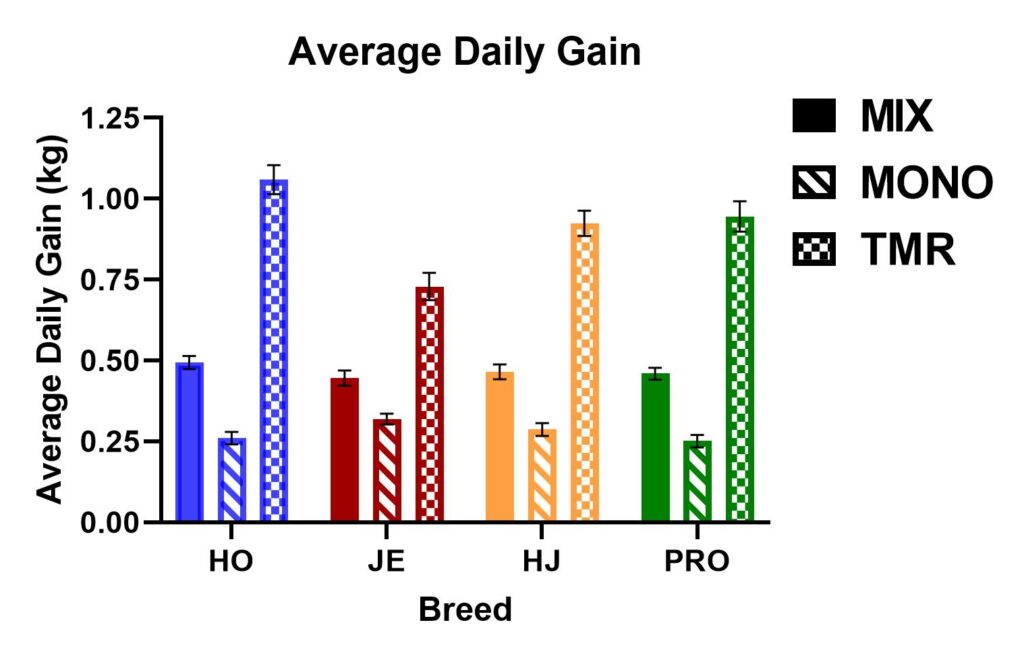
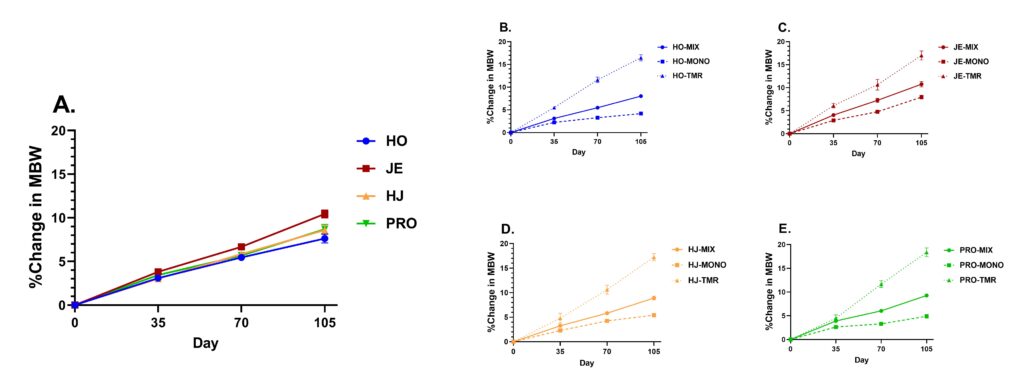
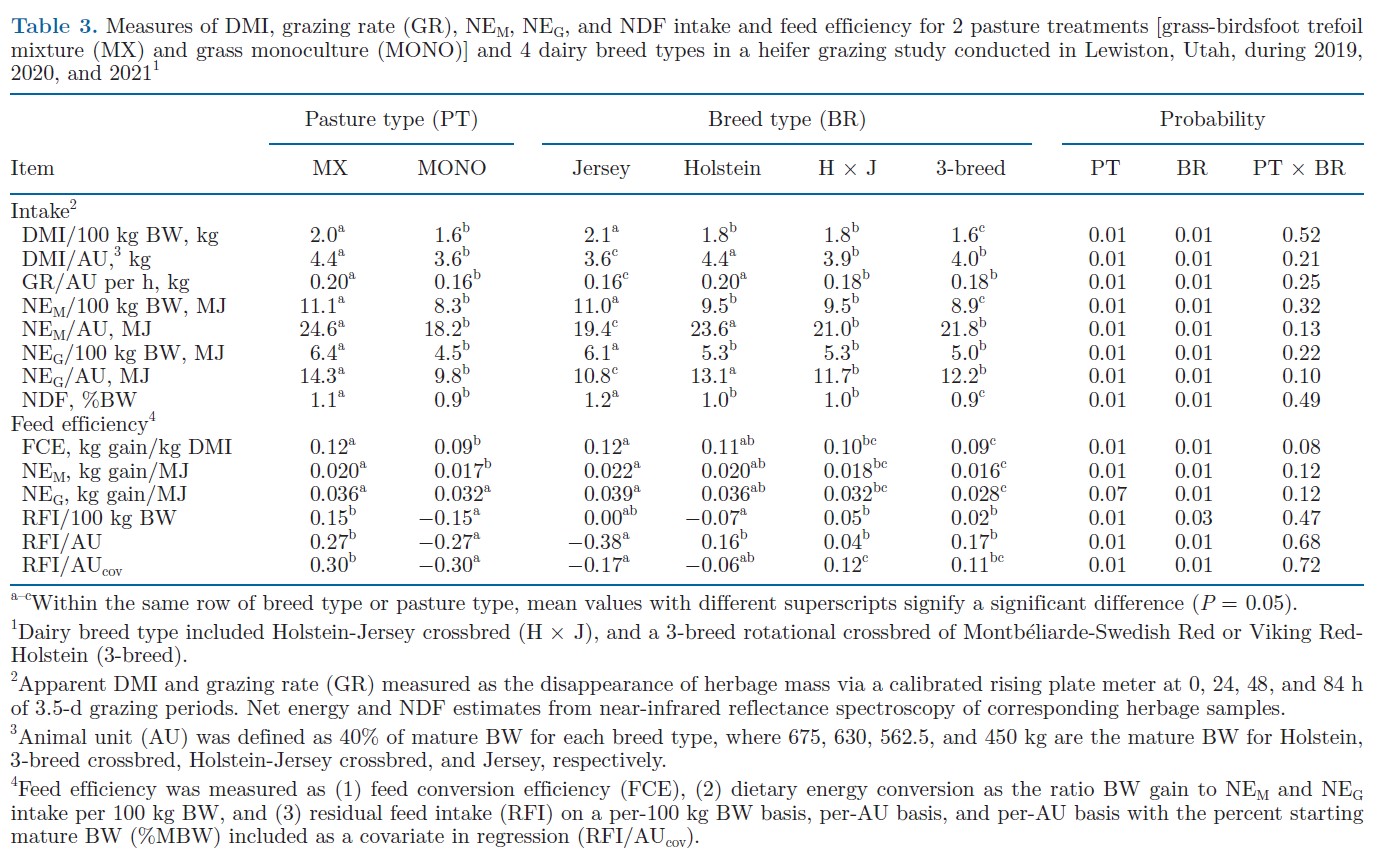
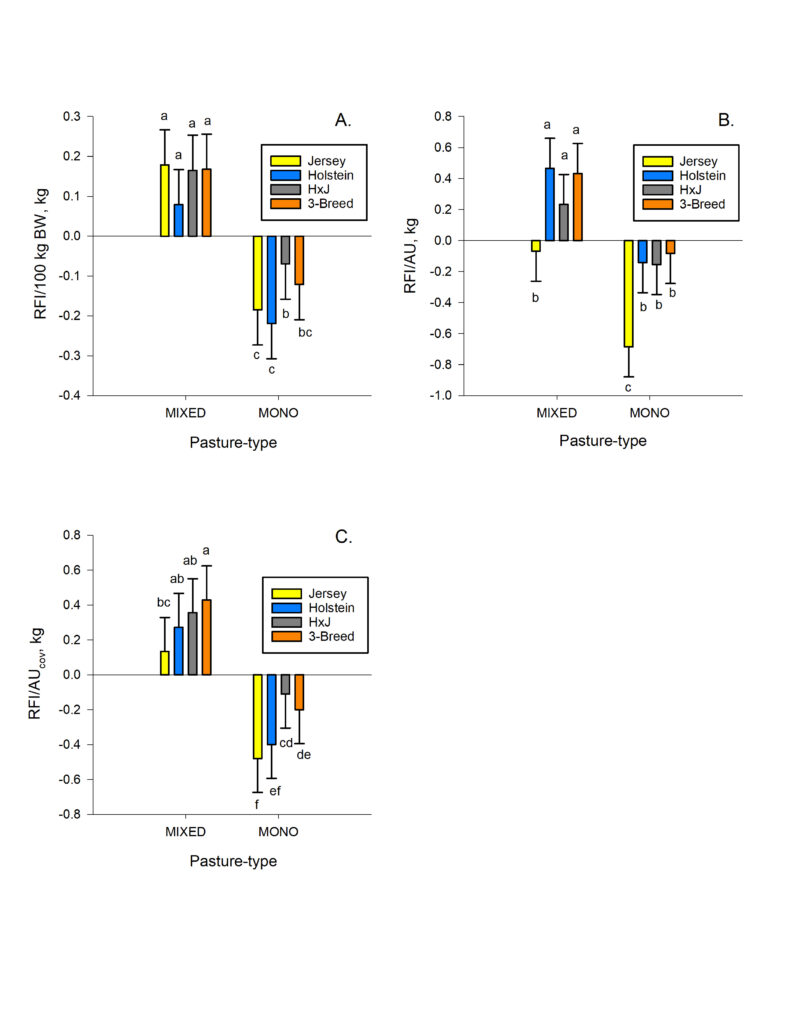
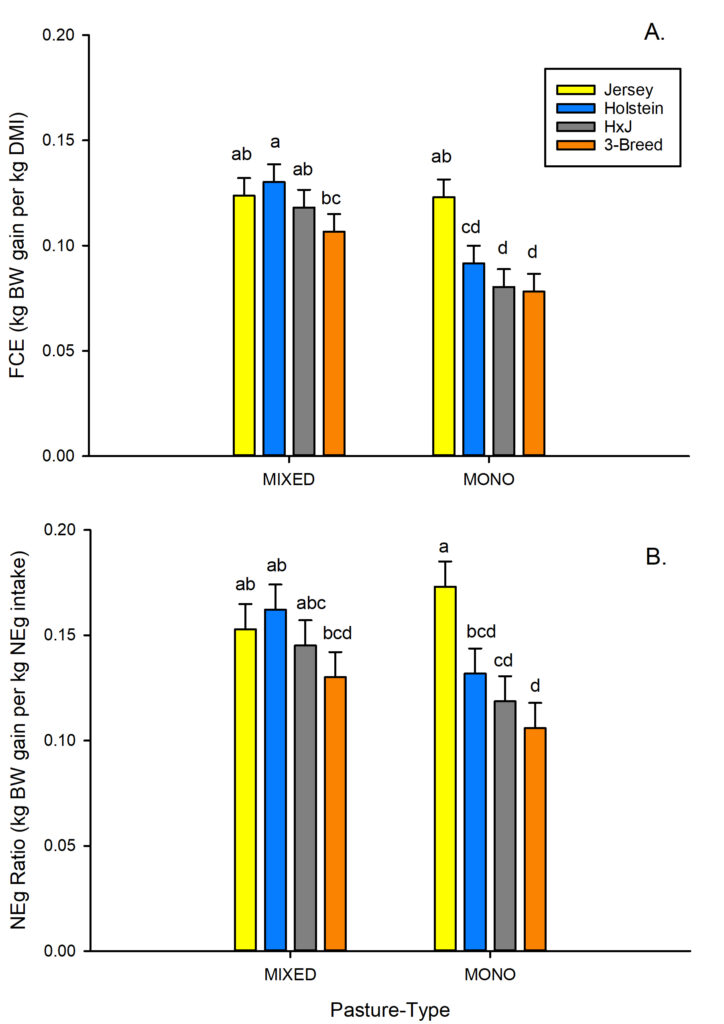
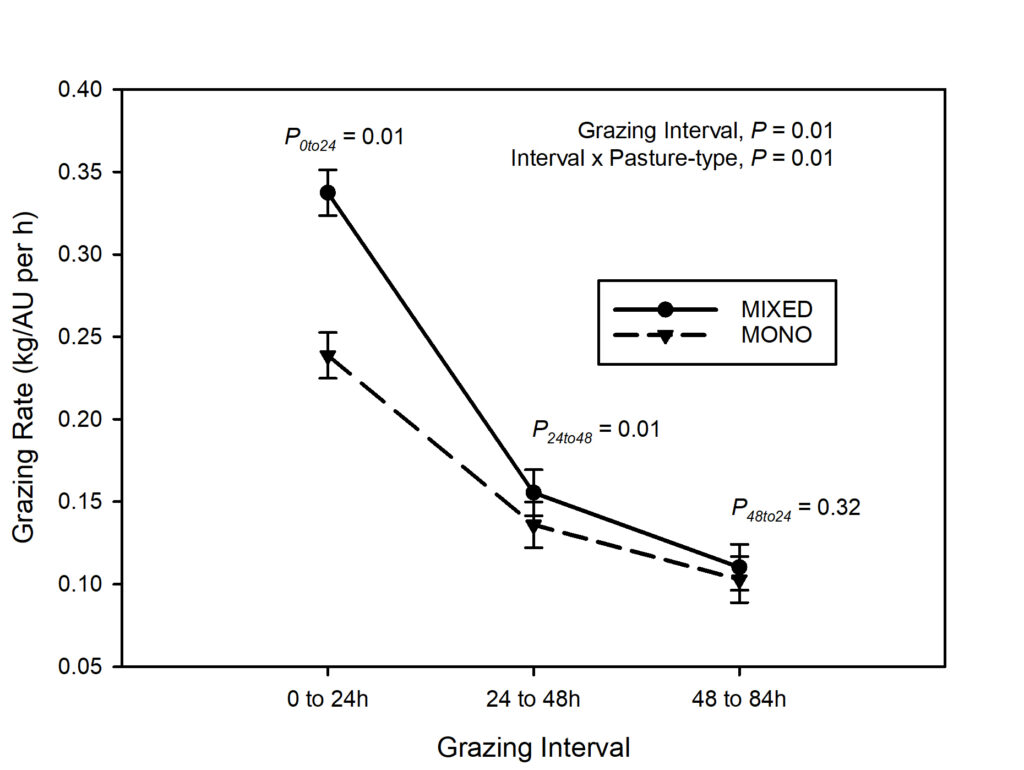
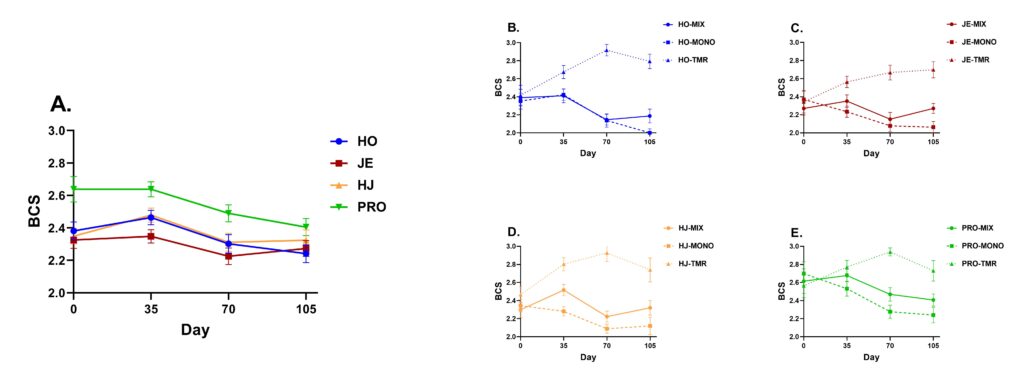
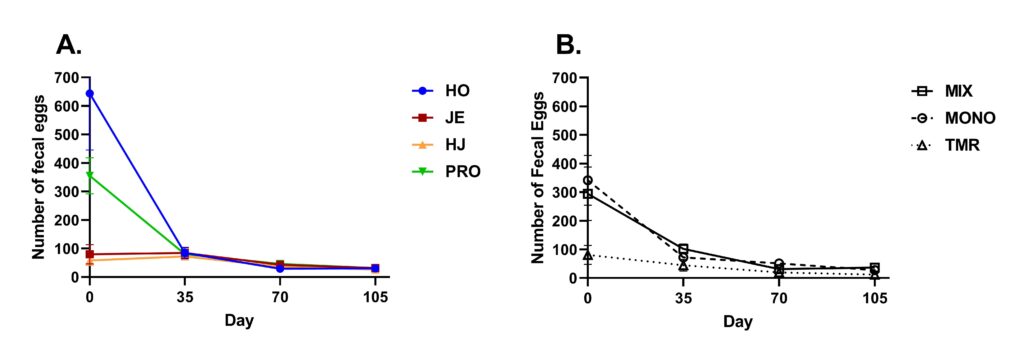
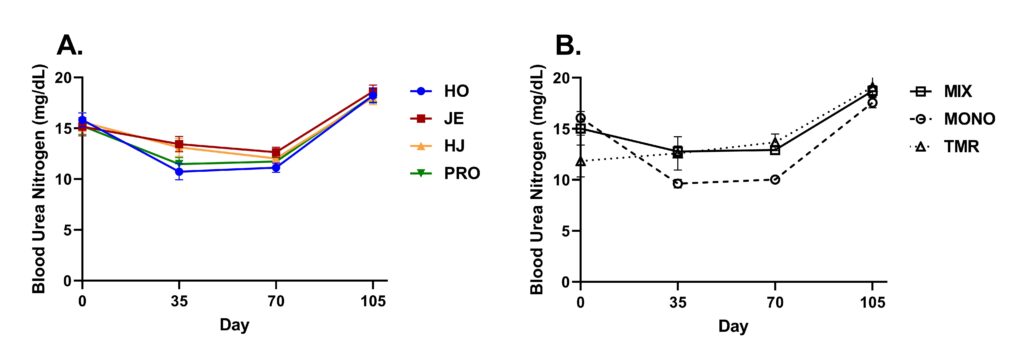

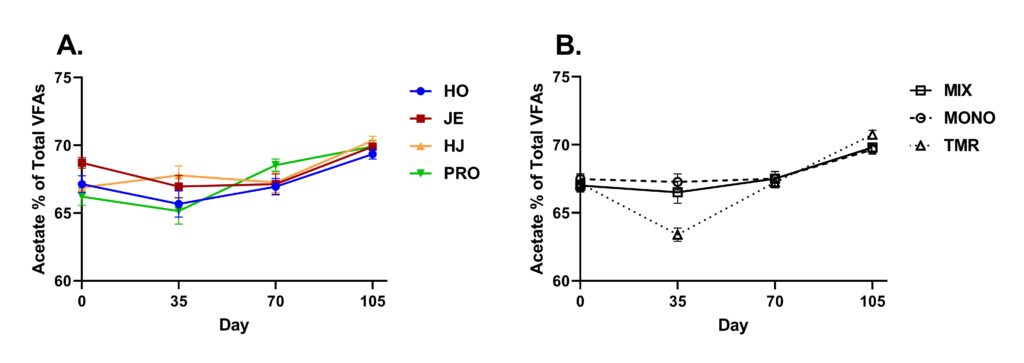

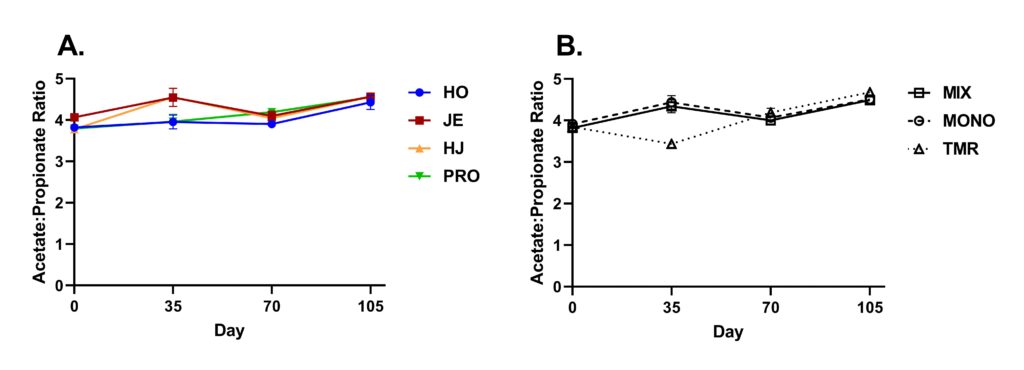
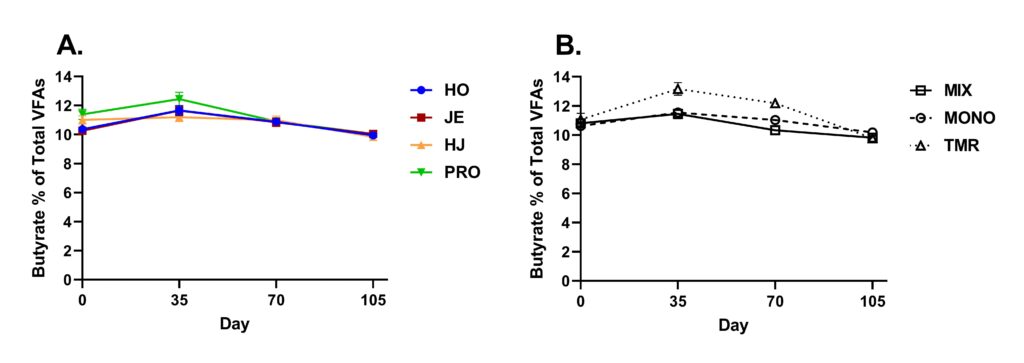
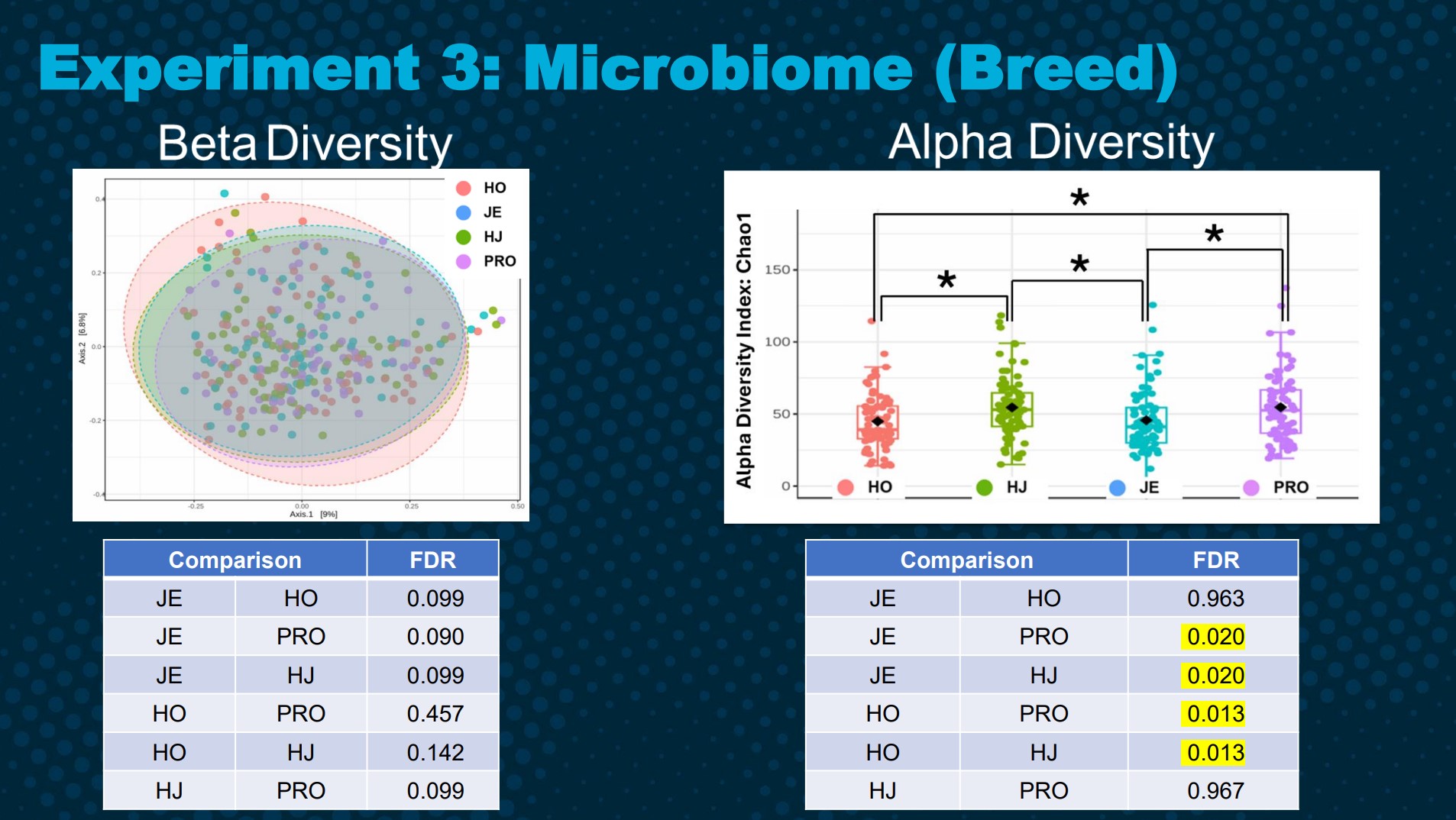
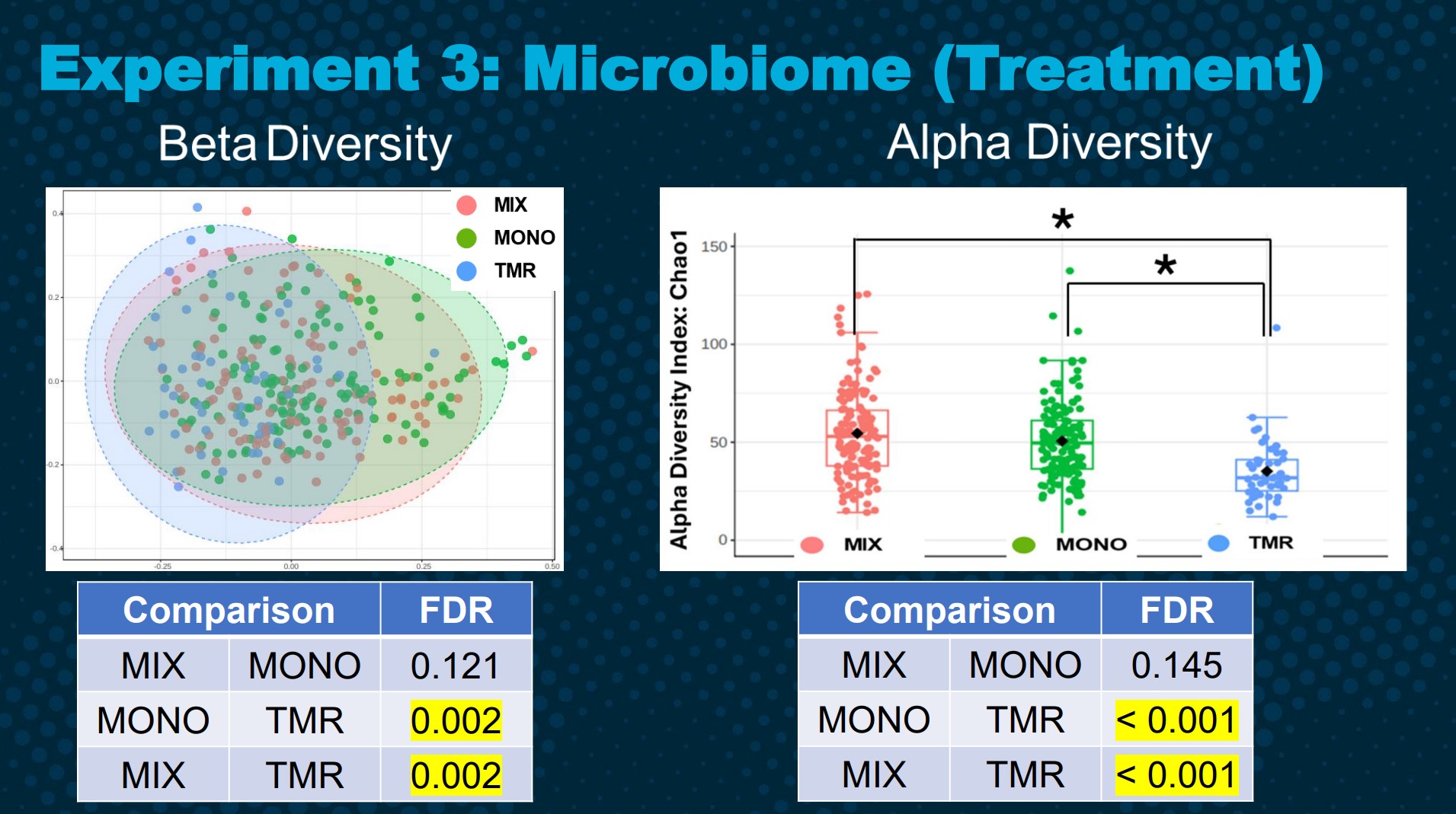
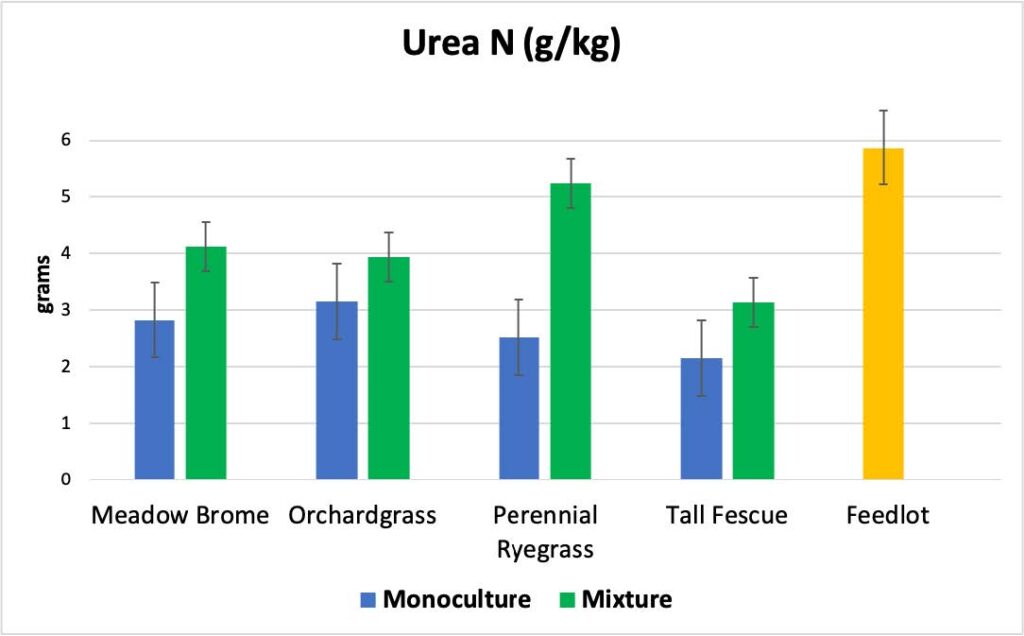
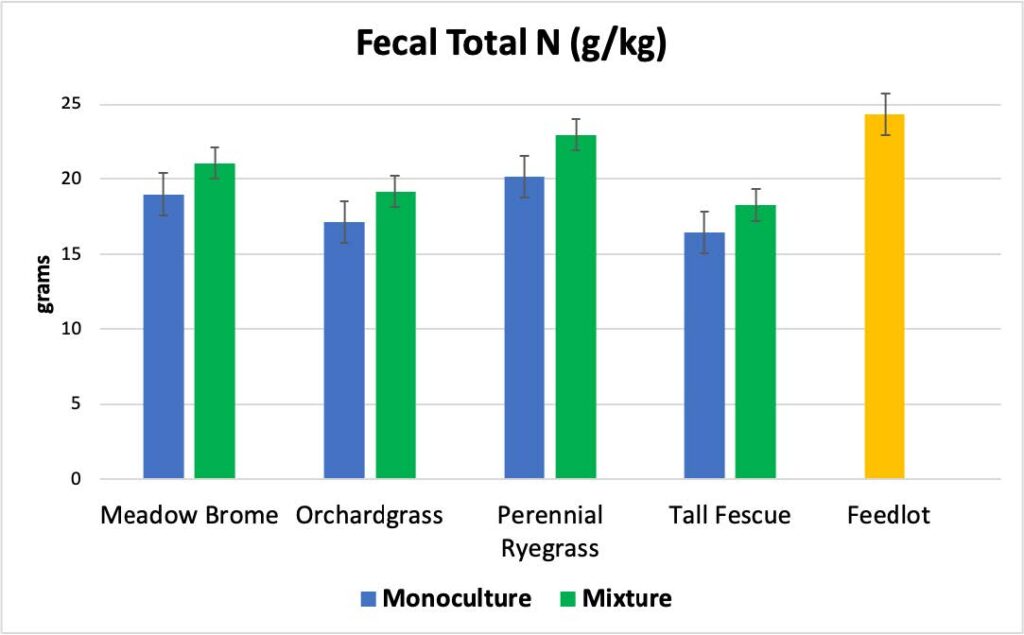
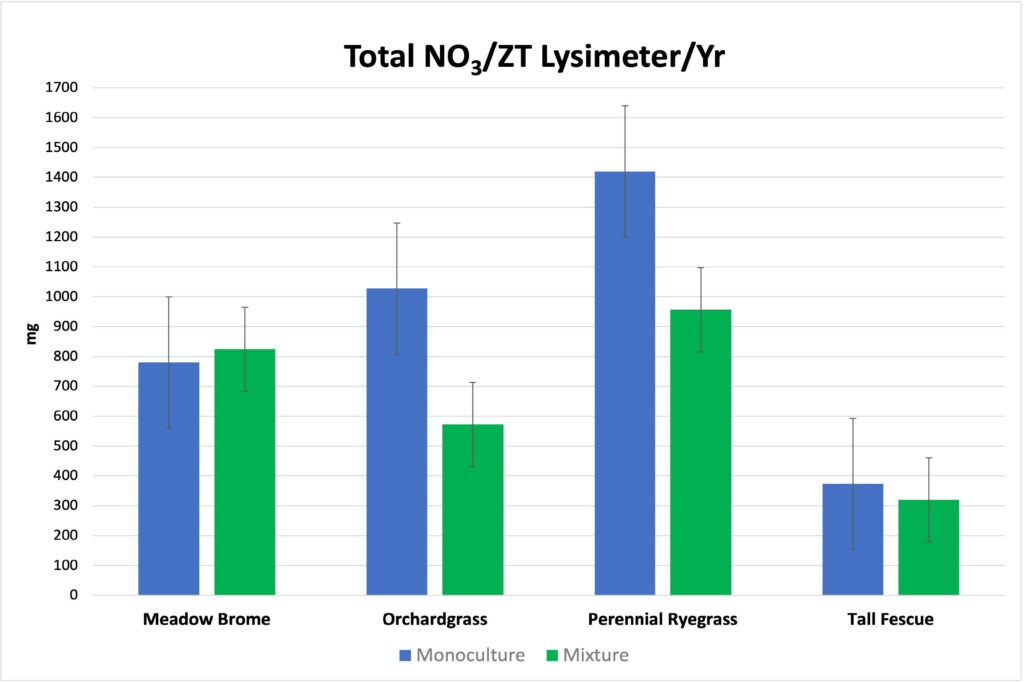
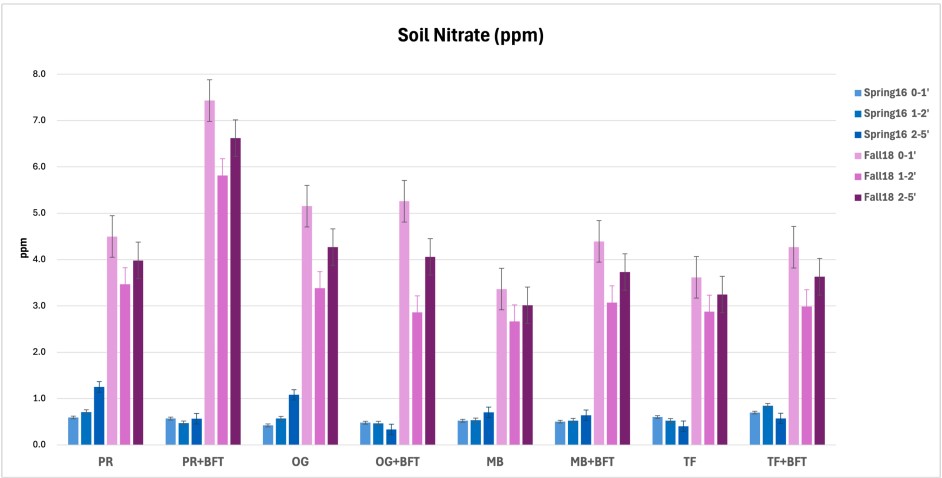
Research outcomes
Research from SW21-927 expanded our previous Western SARE projects that determined grass-legume pastures with different energy, protein, and condensed tannin (CT) levels affected beef steer and Jersey heifer growth performance and economic sustainability (SW10-088 and SW17-046). However, those studies found that forage characteristics only explained approximately 50% of the variation in DMI and growth performance, therefore, this research sought to determine how dairy breed influenced sustainability of replacement heifer programs in pasture-based systems.
The key findings of SW21-927 were:
- Dairy heifers grazing grass-legume mixtures had greater DMI than those grazing grass-only pastures, with Holsteins exhibiting the greatest overall DMI, but Jerseys the most efficient at converting intake to growth performance.
- There was a significant effect of pasture type on average daily gain, with heifers on grass-legume pastures having an average gain of 0.47 kg/day while those on grass only pastures gained 0.28 kg/day on average, but gains on mixed pasture were only about half as much as the heifers on a TMR ration (0.92 kg/day).
- Overall, Jerseys gained a higher percentage of their mature body weight and lost less body condition while on pasture than heifers of other breeds.
- Dairy breed did not differ in ruminal ammonia, or any of the three primary VFA (acetate, propionate, or butyrate) concentrations, but feed treatment (pasture-type and feedlot) did have a minor influence on rumen fluid chemistry.
- Rumen microbiome diversity was affected by both breed and feed treatment and importantly was different between the high and low performing dairy heifers. Seven rumen microbe families were identified as important in these differences.
- Environmentally, the grass-legume mixtures generally exhibited lower nutrient loss due to leaching as the grass monocultures.
- An economic analysis examined the required days on feed (DOF), including a 120-day grazing period followed by a period in feedlot (TMR), required to get heifers from 40% mature body weight (MBW) to breeding weight (55% MBW). Heifers on grazing treatments required significantly more DOF compared to those on feedlot only to reach breeding weight, however, incorporating grazing into heifer development programs always resulted in feed cost savings.
- Jersey heifers had the lowest total feed costs, with the mixed-pasture treatment (120 days grazing + 117 days TMR) ($67/heifer) yielding the greatest savings compared to the feedlot only control (191 days; $102/heifer). Holsteins exhibited the highest total feed costs due to their greater DMI and longer required time in feedlot to reach breeding weight ($113 and $147/heifer for mixed-pasture and feedlot-only, respectively). ProCross crossbred feed costs were similar to Jersey’s ($69 and $101/heifer for mixed-pasture and feedlot only, respectively). Whereas Holstein-Jersey crossbred feed costs were intermediate between the purebreds.
This research affirms and extends previous research suggesting that Jersey heifers may be suited particularly well to grow and mature sexually within pasture-based systems – even with lower quality forages. The results of this study will be of value to dairy producers who might consider cutting costs by raising replacement heifers on pasture and those that otherwise provide pasture as a significant part of their animals’ diet. The notable effect of rumen microbiome diversity on dairy heifer growth/performance under different diets provides an opportunity for dairies to increase the efficiency of dairy heifer replacement through rumen microbiome manipulation. More research in this area is needed. Producers seeking cost efficiency should consider optimized grazing strategies, particularly for breeds with lower maintenance costs and higher feed efficiency. Future research should explore long-term economic impacts, including reproductive performance and first-lactation productivity, to provide a more comprehensive assessment of these feeding strategies. Continued research is needed on the role of genetics in the variation observed for growth performance. Completion of the Neogen Igenity Select Dairy index correlation with DMI, feed efficiency, growth, and rumen microbiome diversity should provide important results that further document the potential of pasture grazing to increase the production and economic sustainability of dairy heifer replacement programs.
Education and Outreach
Participation summary:
Consultations (up to date as of January 31, 2025):
- Responded to 60 questions (phone calls, emails, on-site visits) about grass-legume mixtures for pasture, including how to establish and manage grazing.
Webinars, talks and presentations (up to date as of January 31, 2025):
2021
- Creech, J. Earl. Best practices for grass hay and pasture. USU Pasture/Other Hay Crop School. Virtual. Feb 9, 2021. Attendees: 184.
- Creech, J. Earl. Common mistakes in pasture and grass hay. Tooele Crop School. Tooele, UT. April 14, 2021. Attendees: 50.
- Creech, J. Earl. Grass and legume growth and development. Sustainable Grazing Institute. Panguitch, UT. June 8, 2021. Attendees: 25.
- Creech, J. Earl. Pasture planting tips. Kaysville Farm Field Day. Kaysville, UT. Sept 8, 2021. Attendees: 29.
- Miller, R. L., S. Isom, B. Waldron, K. Rood, E. Creech, M. Peel. 2021. The Nutrient Cycle of Pastured Heifers. Stock and Flock. October 8, 2021. Logan, UT: Utah State University Extension. Attendees: 45.
2022
- Miller, R., B. Waldron, S. C. Isom, K. Thornton-Kurth, K. Rood, E. Creech, M. Peel, J. Hadfield, R. Larson, and M. Rose. 2022. Improving Production and Minimizing Nutrient Loss in Grazing Systems through the Use of Grass-Legume Mixtures. Waste to Worth. Oregon, OH. April 18-22, 2022. Available at: https://lpelc.org/improving-production-and-minimizing-nutrient-loss-in-grazing-systems-through-the-use-of-grass-legume-mixtures/. Attendees: 350 (50 farmers/ranchers, 200 agricultural professionals, 100 academia).
- Creech, J. Earl. Common mistakes in pasture management. Cache County Beef Education Night. Logan, UT. April 7, 2022. (Attendees: 37)
- Greenland, Michael. Dairy Breed, Grass-Birdsfoot Trefoil Mixture, and Pasture Nutrition Effects on Intake, Feed Efficiency and Grazing Adaptation. M.S. thesis defense presentation. Utah State University, Logan. May 2, 2022. Attendees: 35 (3 farmers/ranchers, 2 agricultural professionals, 30 academia).
- Greenland, Michael. Dairy Breed, Grass-Birdsfoot Trefoil Mixture, and Pasture Nutrition Effects on Intake, Feed Efficiency and Grazing Adaptation. eOrganic webinar. May 6, 2022. Available at: Dairy Breed, Grass-Birdsfoot Trefoil Mixture, and Pasture Nutrition Effects on Intake, Feed Efficiency and Grazing Adaptation | eOrganic. Attendees: 44; (763 views, 10 Mar 2025).
- Creech, J. Earl. Grass and legume growth and development. Sustainable Grazing Institute. Kaysville, UT. June 7, 2022. (Attendees: 50)
- Goodey, Chase. Measures of rumen health and function in organic pasture-raised dairy heifers. Presentation at ADVS Student Research Symposium. Utah State University, Logan. August 3, 2022. Attendees: 70.
- Waldron, Connor. Genotypic influence of developing organic dairy heifers. Poster at ADVS Student Research Symposium. Utah State University, Logan. August 3, 2022. Attendees: 50.
2023
- Creech, J. Earl. Pasture fertility and grazing. Rich County Beef and Crop School. Randolph, UT. January 10, 2023. (Attendees: 35)
- Creech, J. Earl. Profitable pasture establishment and renovation. Virtual Pasture Crop School. January 12, 2023. (Attendees: 131)
- Creech, J. Earl. Regenerative pasture management and fall interseeding. Cache County Beef Education Series. Logan, UT. Feb 26, 2024. (Attendees: 25)
2024
- Goodey, Chase. Measures of rumen health and function in organic pasture-raised dairy heifers. M.S. thesis defense presentation. Utah State University, Logan. August 05, 2024. Attendees: 40 (3 farmers/ranchers, 2 agricultural professionals, 35 academia).
Workshop / field days (up to date as of January 31, 2025):
2023
- The USU Pasture Virtual Crop School. co-organized, J.E. Creech. January 12, 2023. (131 total participants)
- Utah State University/University of Idaho Extension/USDA Irrigated Pasture Field Day. July 13, 2023. Participants: 35 total. 13 farmers/ranchers, 14 agricultural professionals, 8 academia.
- The following presentations related to this project were given:
- Stop 1 – By the new planting.
- Welcome and overview of history and future of USU grazing research – Earl Creech and Ross Israelson
- Establishing new pastures – choice of plants, methods, and weed control – Drs. Earl Creech and Corey Ransom (USU)
- Stop 2 – Pasture C – Ryegrass/BFT and temporary chute.
- Sweetening up the pasture by planting legumes into established grass and choice of legumes – Dr. Mike Peel (USDA)
- Troublesome weeds in pasture and emerging issues with pasture herbicide residual in manure/composting – Dr. Corey Ransom (USU)
- Walk and view 4 grasses mixed with BFT – Pasture D west side (Northeast pasture)
- Extension resources for pastures and grazing – Bracken Henderson (Univ of Idaho Extension, Franklin County Idaho) and Justin Clawson (Utah State University Extension, Cache County).
- Dairy Heifer/Grazing research – Dr. Clay Isom (USU)
- Overview of 3 grazing studies – including Jersey study
- The effect of dairy breed and pasture-type (grass and grass-legume mixtures) on heifer growth performance – Sawyer Fonnesbeck, Univ. of Idaho Extension, Onieda County (former graduate student)
- The effect of dairy breed and pasture-type (grass and grass-legume mixtures) on rumen microbes – Chase Goodey, grad student.
- The effect of dairy breed genetics on grazing efficiency and – Connor Waldron, grad student.
- The effect of dairy breed and pasture-type (grass and grass-legume mixtures) on herbage intake and grazing efficiency – Dr. Blair Waldron (USDA)
- Walk and view 4 grasses in monoculture without BFT – Pasture D eastside
- Fencing for rotational grazing – Jacob Hadfield (USU Extension, Juab County; former graduate student)
- Pasture fertility – options other than commercial fertilizer – Greg Bingham (dairy farmer/producer)
- Economics of grazing – Dr. Ryan Larson
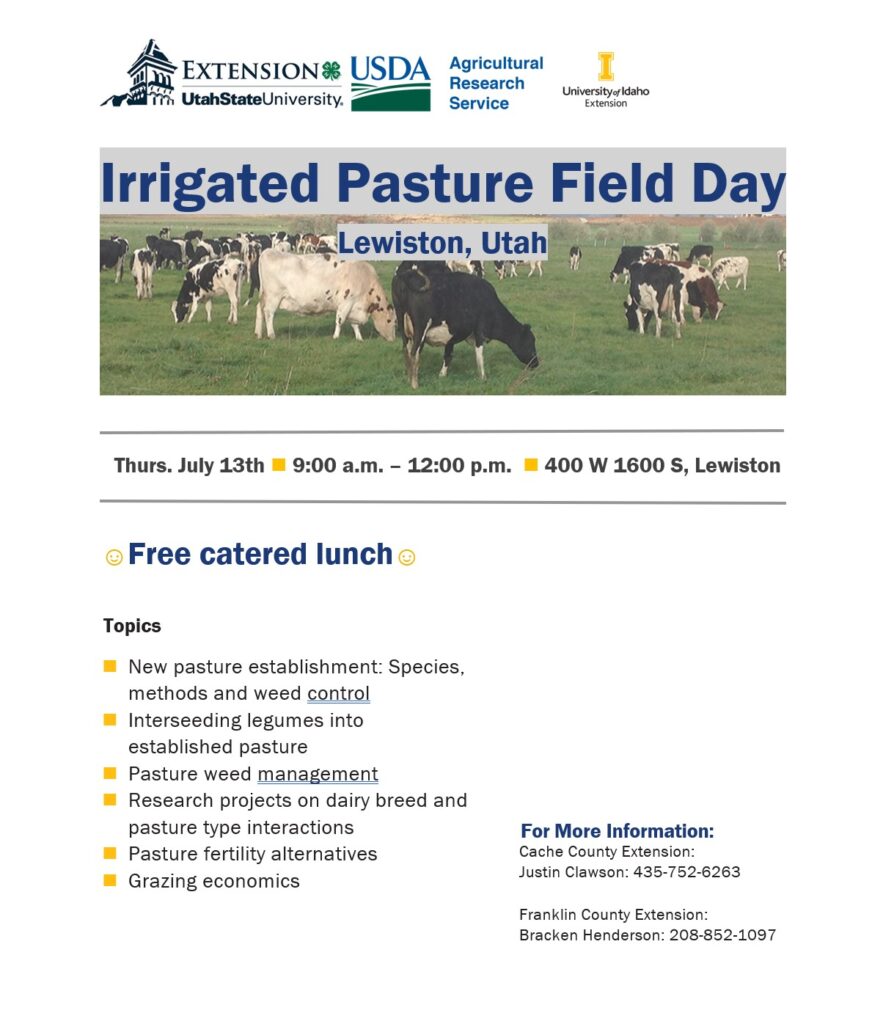
2022
-
The USU Sustainable Grazing Institute. co-organized, J.E. Creech. June 7-9, 2022. Kaysville, UT (35 participants)
2021
- Utah State University Lewiston Pasture Research Farm field day. July 28, 2021. Lewiston, Utah. Participants: 41 total. 15 farmers/ranchers, 11 agricultural professionals, 5 academia.
- The following presentations related to this project were given:
- Clay Isom. Dairy heifer grazing project overview.
- Michael Greenland, USU graduate student. Dry Matter Intake and Feed Efficiency of Four Dairy Breeds in Pasture-Based Heifer Development.
- Sawyer Fonnesbeck, Idaho State University Extension and former graduate student on project. The Influence of Cattle Breed and Forage Type on Dairy Heifer Performance
- Rhonda Miller. N-Cycling in Organic Dairy Grazing Systems.
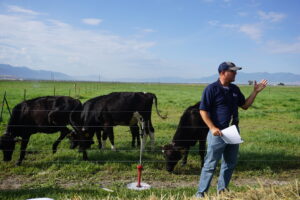
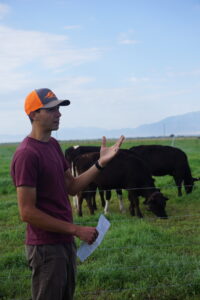
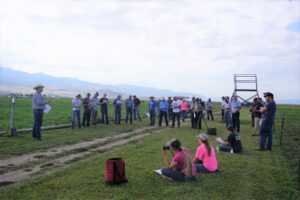
Other Educational and Outreach Activities (up to date as of January 31, 2025):
-
Field tours – 15 tours of the Lewiston pastures during with small groups of producers, professionals, and students during the grant period.
- A web site for the project was established through eOrganic in a previous related Western SARE grant, SW17-046 (found at https://eorganic.info/node/33809; verified 4/28/22). The project SW21-927 is an extension and continuation and will be using the same website. Information on the website will be updated to reflect the new project. As publications, presentations and trial results from the projects become available, we will make them available here.
- Creech, E. 2020. What should I plant in my pasture? Utah State University Extension YouTube Channel. https://www.youtube.com/watch?v=xAcbTnzEMUs&list=PLMnDQoXFVBEZXfoSqJSNf_daMgMLi_-cM&index=61 (236 views, 10 Mar 2025)
- Creech, E. 2021. Best practices for grass hay and pasture. Utah State University Extension YouTube Channel. https://www.youtube.com/watch?v=foWCzW8cLyk&list=PLMnDQoXFVBEZXfoSqJSNf_daMgMLi_-cM&index=104 (1,600 views, 10 Mar 2025)
- Miller, R. L., S. Isom, B. Waldron, K. Rood, E. Creech, M. Peel. 2021. The Nutrient Cycle of Pastured Heifers. Stock and Flock. October 8, 2021. Logan, UT: Utah State University Extension YouTube Channel. https://www.youtube.com/watch?v=upmrnf_hdlU&t=10s. (212 Views, August 1, 2023).
- Greenland, M. Dairy Breed, Grass-Birdsfoot Trefoil Mixture, and Pasture Nutrition Effects on Intake, Feed Efficiency and Grazing Adaptation. eOrganic webinar. https://eorganic.org/node/35394 (763 views, 10 Mar 2025)
- Creech, E. 2023. How to establish and renovate pastures. Utah State University Extension YouTube Channel. https://www.youtube.com/watch?v=UEulUqdxwJc&list=PLMnDQoXFVBEZXfoSqJSNf_daMgMLi_-cM&index=9 (372 views, 10 Mar 2025)
Publications (up to date as of January 31, 2025):
- Fonnesbeck, Sawyer. Influence of cattle breed and forage type on organic dairy heifer performance. M.S. thesis, Utah State University, Logan. 2021.
- Miller, R., B. Waldron, S. C. Isom, K. Thornton-Kurth, K. Rood, E. Creech, M. Peel, J. Hadfield, R. Larson, and M. Rose. 2022. Improving Production and Minimizing Nutrient Loss in Grazing Systems through the Use of Grass-Legume Mixtures. eXtension Waste to Worth: Advancing Sustainability in Animal Agriculture. Waste-to-Worth Proceedings. Oregon, OH. April 18-22, 2022. Available at: https://lpelc.org/improving-production-and-minimizing-nutrient-loss-in-grazing-systems-through-the-use-of-grass-legume-mixtures/.
- Greenland, Michael. Dairy Breed, Grass-Birdsfoot Trefoil Mixture, and Pasture Nutrition Effects on Intake, Feed Efficiency and Grazing Adaptation. M.S. thesis, Utah State University, Logan. 2022.
- Greenland, Michael S., Blair L. Waldron, S. Clay Isom, Sawyer D. Fonnesbeck, Michael D. Peel, Kerry A. Rood, Kara J. Thornton, Rhonda L. Miller, Jacob A. Hadfield, Brecken Henderson, and J. Earl Creech. 2023. Dry matter intake and feed efficiency of heifers from 4 dairy breed types grazing organic grass and grass-birdsfoot trefoil mixed pastures. Journal of Dairy Science. 106:3918-3931. https://doi.org/10.3168/jds.2022-22858. (Accepted 12/30/22; Published 4/25/23).
- Goodey, Chase T. Measures of Rumen Health and Function in Organic Pasture-Raised Dairy Heifers. M.S. thesis, Utah State University, Logan. 2024.
- Fonnesbeck, S. D., C. T. Goodey, B. L. Waldron, M. S. Greenland, K. J. Thornton, J. E. Creech, R. Stott, A. Sweat, K. A. Rood, R. Larsen, R. L. Miller, and S. C. Isom. The influence of dairy breed and forage type on organic dairy heifer performance. Journal of Dairy Science. (In Review).
Education and Outreach Outcomes
Education and outreach efforts should always be guided by input from producer cooperators and similar stakeholders. Our audience was a combination of agricultural producers, students, agency personnel, industry representatives, and other professionals who had a variety of preferences for receiving information. Consequently, multiple dissemination tactics integrating traditional outreach with electronic media were employed during the granting period for WSARE SW21-927 project, "Dry Matter Intake and Feed Efficiency of Four Dairy Breeds in a Pasture-Based Heifer Development Program." Field tours and field days at the actual research site are often the gold-standard for educational events because they allow a participant to see what is going on in the field and ask questions. During this project we organized 4 events with over 240 participants. Another 18 presentations allowed us to take information from the experiments and deliver it to a much larger audience, reaching 1,240 participants that were unable to come to the research site. Survey data from these meetings showed that 99% of farmers and crop consultants indicate the programming increased their knowledge and understanding of agricultural sustainability and 98% intended to use the information. Furthermore, the size and scope of our audience was greatly increased via electronic media such as YouTube and eOrganic videos. Five videos were recorded and posted, reaching over 500 original connections with subsequent views totaling nearly 3,200.
In addition to increasing stakeholder’s understanding of how pasture grazing can affect dairy heifer replacement sustainability, this project included hands-on training for three graduate and 10 undergraduate students. Three master’s level theses were completed during the granting period. One of these students has since moved into an Ag Service Provider position (Agricultural Extension and Education) and another is interviewing with companies for livestock nutrition positions. Their experiences on this project with animal husbandry practices and grazing principles, increased their understanding of sustainable livestock management and helped qualify them for these positions. Also, during this project, approximately 20 veterinary students, 12 pre-veterinary medicine students, and 2 Master of Public Health (MPH) students participated in animal research under the direct supervision and mentorship of USU clinical veterinarians and faculty, with oversight from the Institutional Animal Care and Use Committee (IACUC). These students gained hands-on experience in essential clinical and research skills, including venipuncture, urine and fecal sample collection, and rumen fluid collection. Additionally, they were exposed to animal husbandry practices and grazing principles, providing them with a broader understanding of sustainable livestock management. Their involvement also facilitated direct collaboration with master's students, offering valuable insight into graduate-level research and academic pathways. This WSARE-funded research project provided exceptional experiential learning opportunities for College of Veterinary Medicine students, enhancing their practical competencies, and fostering interdisciplinary collaboration in animal health and production research.
- Grass-legume mixtures improve dairy heifer forage intake, health, and performance compared to grass monocultures.
- Dairy breeds differ in amount of forage intake and efficiency of converting that intake into growth.
- Pasture grazing is economically beneficial to get replacement dairy heifers to breeding weight.
Choosing the best forages to include in pasture mixtures.
Moving towards more Jersey's in herd due to their greater grazing efficiency compared to other tested dairy breeds.
